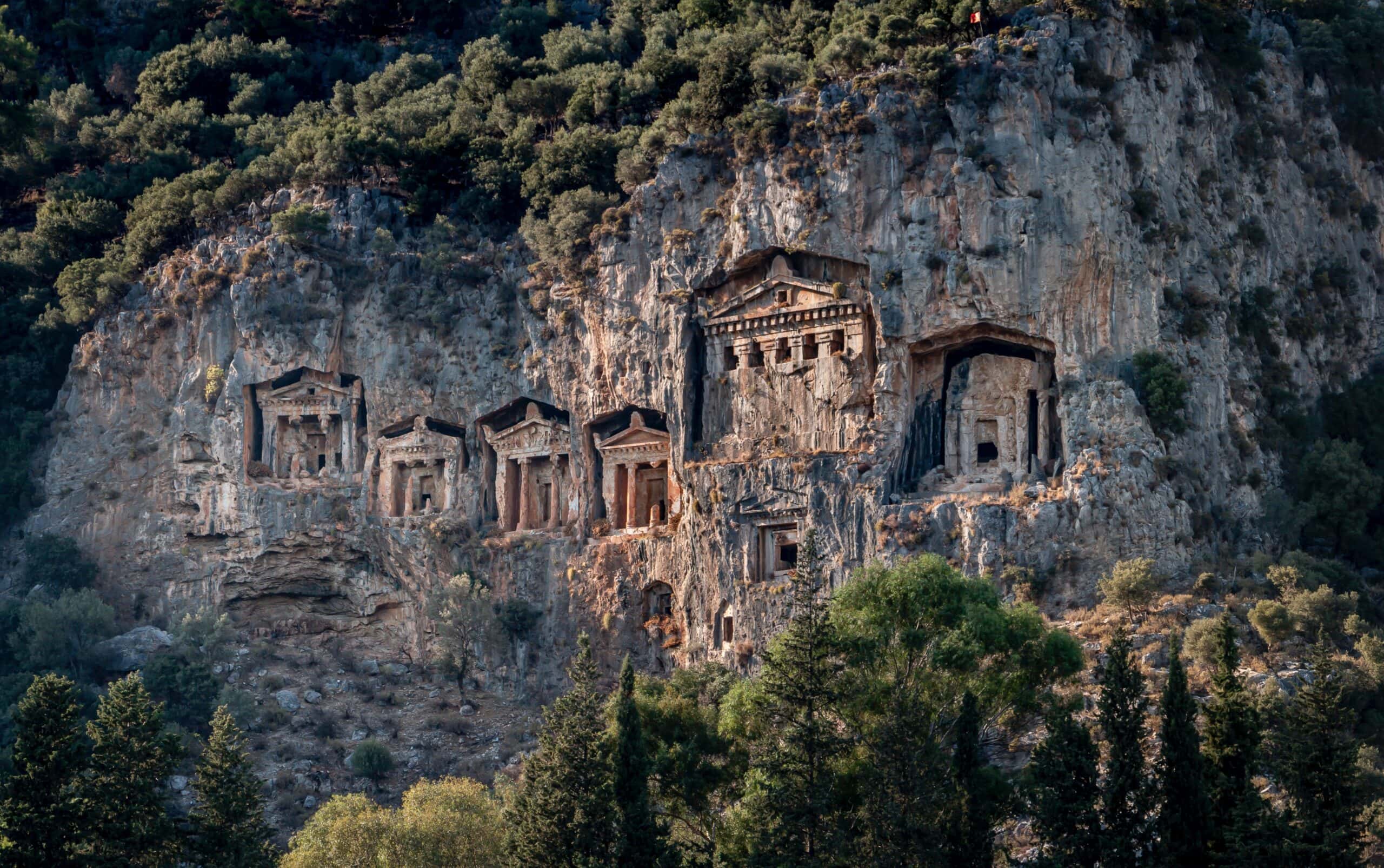39 Famous Landmarks in Turkey to Inspire Your Travels
Looking for the most famous landmarks in Turkey?
Then you’ve come to the right place!
Turkey is a country full of history and diverse cultures and boasts many landmarks that attract millions of visitors each year. As one of those visitors, I was amazed by the breadth of historic landmarks I saw in Turkey. From the remnants of long-forgotten civilizations to stunning natural wonders, Turkey really has it all.
In this post, I cover the top Turkish landmarks across the country that will inspire your travels to Turkey. Whether you’re interested in history, architecture, or simply capturing breathtaking photographs, Turkey has a plethora of famous sites that will leave you in awe. From popular landmarks such as the Galata Tower and Hagia Sophia in Istanbul to lesser-known gems like the Sephardic synagogues of Izmir. Let this article spark your wanderlust as you plan the best possible trip to Turkey.
Please note this post may contain affiliate links. If you click on one, I may earn a small commission at no extra cost to you. See my Privacy Policy for more information.
Famous Turkish Landmarks in Istanbul
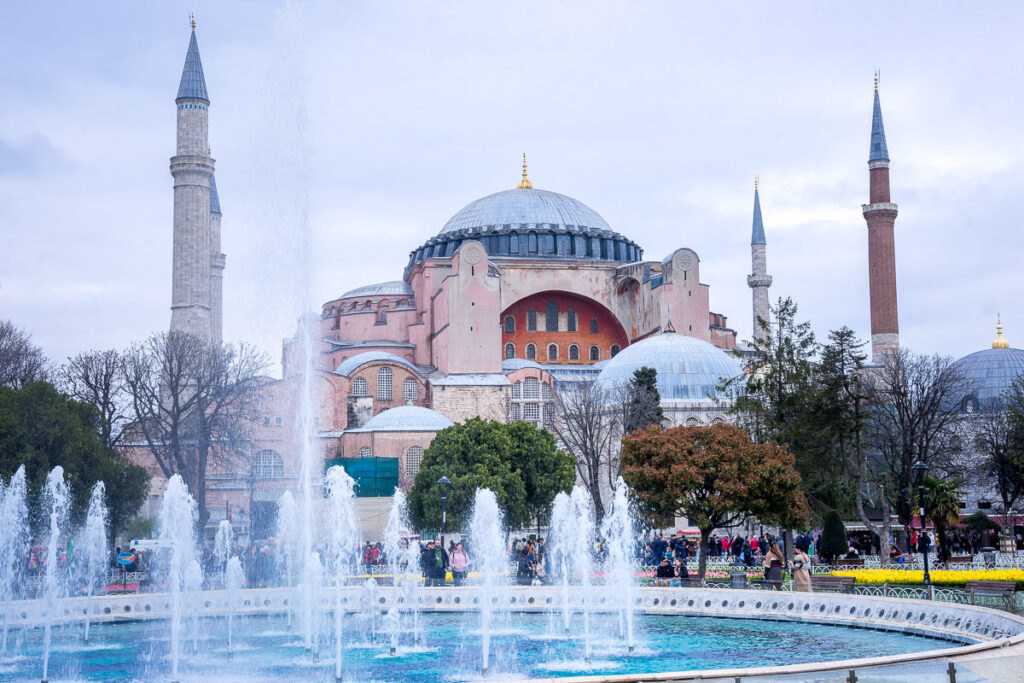
Hagia Sophia
Explored by De Wet and Jin of Museum of Wander
The Hagia Sophia is arguably one of the most famous Turkish landmarks and an absolute must on any Istanbul itinerary.
Located in the Sultanahmet neighborhood in the historic centre of Istanbul, the Hagia Sophia is a living testament to centuries of history. Originally built as a cathedral in 537 CE by the emperor Justinian, it was later converted into a mosque, then served as a museum, and finally reverted back to a functioning mosque. It’s now officially called the Hagia Sophia Grand Mosque.
Its significance lies in its architectural magnificence and its role as a cultural crossroads where the East and West converge. With its massive dome, intricate mosaics, and the juxtaposition of Christian and Islamic elements, the Hagia Sophia reflects the ebb and flow of empires and beliefs. It has witnessed the rise and fall of civilizations, each leaving an indelible mark on its walls.
A visit to the Hagia Sophia is a condensed tour of Istanbul’s entire history, as the building reveals layers of history and cultures that have shaped the city.
The distinct pale-pink exterior of the building hides an incredible interior of golds and yellows. Its most outstanding architectural feature is its colossal dome, which stands without central support. On the walls and ceiling, Byzantine Christian mosaics rub shoulders with Arabic characters from the Quran.
As Istanbul’s most famous sight, expect a long line to get in. The good news is you’ll get free entry, as it’s a functioning mosque, and visitors from all religions are welcome. Please dress appropriately for a place of worship; women are expected to cover their hair.
Lines to get into the Hagia Sophia might seem long, but they actually move fast. Don’t lose hope when you see the queue – it’s absolutely worth waiting for and a sight you’ll remember for years to come.
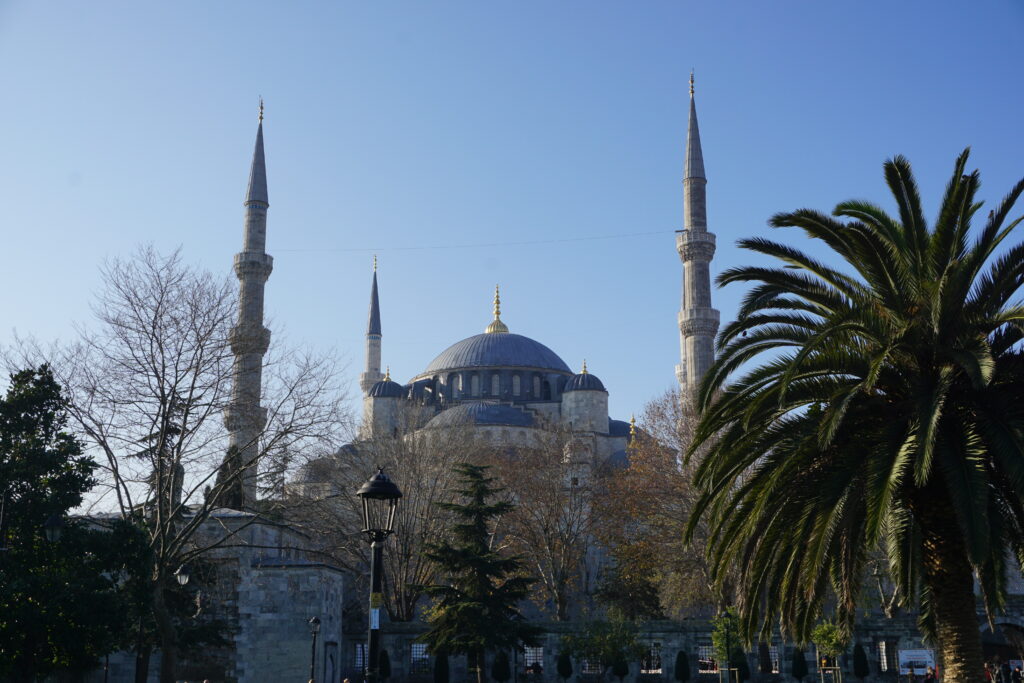
Blue Mosque
Explored by Sarah of Mukikapup’s Travels
The Blue Mosque is an Istanbul icon and UNESCO World Heritage Site that’s located in the Sultanahmet neighborhood right across from the Hagia Sophia. Its actual name is the Sultan Ahmed Mosque, but it’s called the Blue Mosque because of all the blue elements inside the mosque, plus the unique blue exterior. Another possible reason for the nickname is that the sailors saw the blue of the Sea of Marmara reflected in the mosque as they sailed by.
The Blue Mosque was built during the Ottoman era from 1609-1617, during the reign of Ahmed I who was only 13 when he became sultan. It remains a working mosque today, as well as one of the most popular tourist destinations in Turkey. It has classical Ottoman architectural elements including a courtyard, six minarets, and multiple semi-domes that dominate Istanbul’s skyline, plus one of the most popular things to see and photograph: thousands of blue Iznik tiles and paintings inside the mosque.
Beyond the mosque itself, the complex includes more structures including the Mausoleum of Ahmed I, a madrasa, hospital, kitchen, school, and market street that is an open bazaar today.
The Blue Mosque is a must-visit, but visitors should be aware that it will be closed for prayers three times a day. You’ll need to take off shoes at the entrance, and women will need to be dressed modestly and cover their heads. You also might encounter lines to enter this popular site. People outside who will offer guided tours or skip-the-line entry for an extra fee, but be sure to check that they are credentialed guides before accepting. The mosque is free to visit, but donations are accepted.
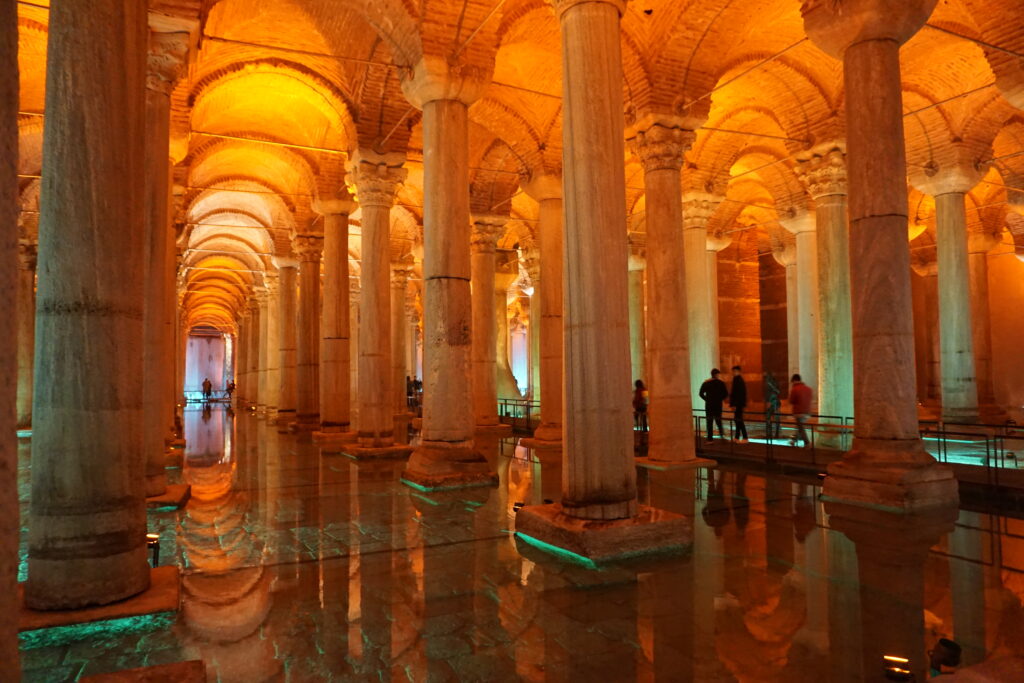
Basilica Cistern
Explored by Violeta of VioletaMatei.com
The Basilica Cistern, also known as Yerebatan Sarnici, or the Sunken Cistern, is definitely worth a visit while in Turkey.
The extremely important role of this underground cathedral was to supply water to the Great Palace of Constantinople, the Byzantine city and former Turkish capital now called Istanbul.
When full, the cistern can hold an astounding 100,000 tons of water. In order to do this, the underground reservoir had to rely on 336 stone pillars connected through cross-shaped vaults. The pillars were repurposed from Roman structures, and three of these pillars bear special features: two rest on heads of Medusa and a third is covered in a peacock pattern.
Nowadays, the Basilica Cistern only holds enough water to cover the bottom and impress tourists. Visitors walk along special decks suspended just above the water.
The Basilica Cistern is located in the center of Istanbul in Sultanahmet Square. You can visit it on a guided tour lasting 30 minutes to one hour.
The Basilica Cistern is accessible to wheelchair users thanks to a platform lift located by the exit on Alemdar Street.
If you want to visit, my personal advice is to either show up early, at least 30 minutes before the opening time, or buy a skip-the-line ticket to avoid the crowds.

Grand Bazaar
Explored by Soumya of Stories by Soumya
The Grand Bazaar in Istanbul is one of Turkey’s top landmarks. Dating to the 15th century, it is one of the oldest, still-operating marketplaces in Turkey and the world.
The Grand Bazaar is home to over 60 lanes that house more than 4,000 stores selling everything from spices and sweetmeats to Turkish carpets and lamps. It is literally the best place to pick up souvenirs from Turkey.
Sultan Mehmed II ordered the construction of the Grand Bazaar, also known as Kapalıçarşı (covered marketplace), right after he conquered Constantinople in 1453 CE. The market was a means to herald economic prosperity in the empire while providing an excellent place for vendors to display their wares and people to shop.
Today, the Grand Bazaar is not just the best shopping venue but also a great place to immerse yourself in Turkish history and culture.
As you walk through the lively streets of Grand Bazaar passing glittering lamps and shiny ceramics, be sure to notice the market’s gorgeous arched walkways, fresco-covered walls, and medieval water fountains. Engage with shopkeepers as they tell you stories about their goods and hometowns. Stop to savor some Turkish coffee or other traditional beverages. The Grand Bazaar is truly an experience waiting to be savored.
Whether you’re visiting Istanbul for one day or more, be sure to head to the Grand Bazaar, an epitome of Turkish history. Located in the Fatih District of Istanbul, only a stone’s throw away from the Historic Center, the Grand Bazaar is easy to get to by tram, metro, and bus.
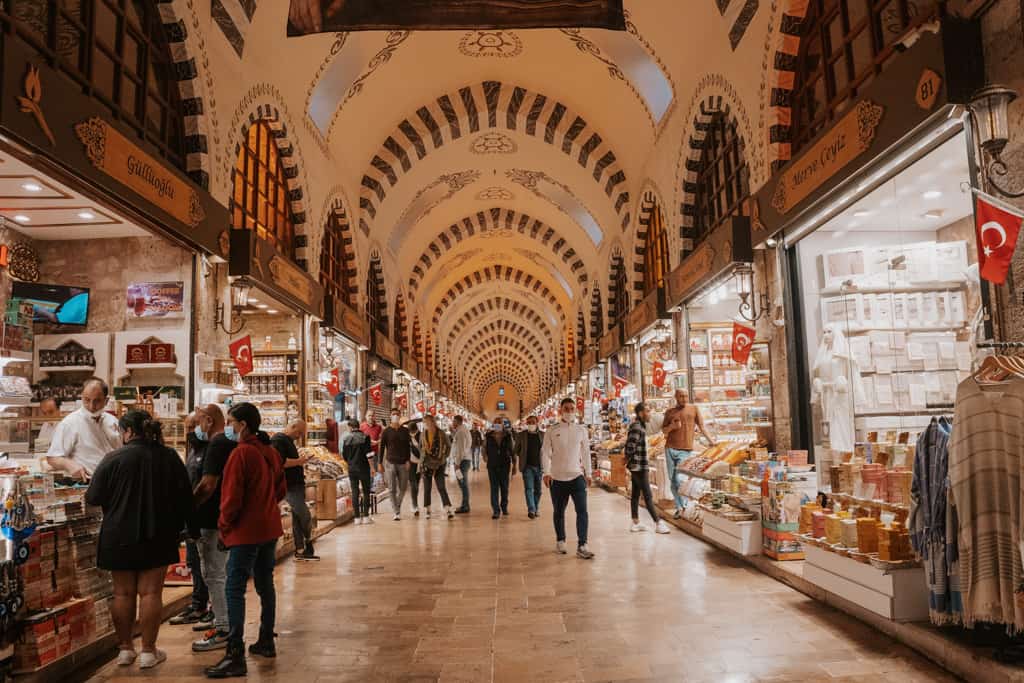
Spice Market
Explored by Haley of Haley Blackall Travel
Nestled in the heart of Istanbul, the Spice Market, also known as the Egyptian Bazaar, is a feast for the senses. Established in the 17th century, this market was initially the final stop for camel caravans traveling the Silk Road. It’s not just a marketplace, it’s a living museum that showcases Turkey’s rich trade history and culinary culture.
Located in the Eminönü quarter of the Fatih district, one of the most central areas to stay in Istanbul, the Spice Market is easily accessible by tram, ferry, or a leisurely walk from the iconic Blue Mosque. You don’t need a car to get here, but if you’re driving, be prepared for Istanbul’s notorious traffic.
Walking into the market, you’re greeted by an explosion of colors and scents. From saffron to sumac, Turkish delight to herbal teas, the array is dizzying. Don’t miss out on tasting the local cheese or picking up some dried fruits and nuts. The vendors are generally friendly and open to haggling, so flex those negotiation muscles. Generally speaking, you won’t find any price tags here, so do some research on spice costs before visiting.
Now, a heads-up: the market can get incredibly crowded, especially on weekends. If you’re not a fan of tight spaces, aim for a weekday visit. Also, while the main hall is wheelchair accessible, some of the smaller shops and crowded conditions might pose challenges for those with mobility issues.
So, if you’re in Istanbul and want to experience a slice of daily Turkish life while picking up some exotic spices either for yourself or as a souvenir for family and friends back home, the Spice Market is your go-to spot.
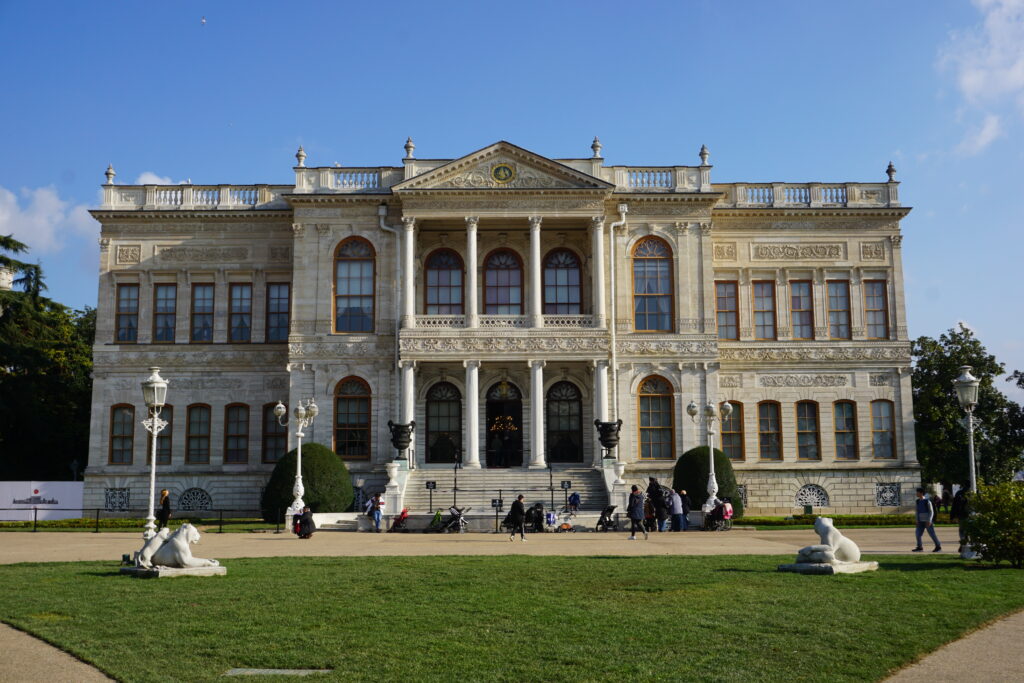
Dolmabahçe Palace
Explored by Shweta of Zest in a Tote
Istanbul has some of the best landmarks in Turkey, and Dolmabahce Palace is one of them. Located in the Besiktas area of Istanbul, it is the largest palace in Turkey. It’s a bit further out from the Historic Center, so I recommend you spend at least 3 or 4 days in Istanbul to give yourself plenty of time to get there.
Dolmabahce Palace was built between 1843 and 1856 on the orders of the 31st Sultan of the Ottoman Empire. The construction of this new palace replaced Topkapi Palace, which they found lacking in comfort and modern style, as home of the Ottoman rulers. After the establishment of the Turkish Republic in 1923, Mustafa Kemal Ataturk used the Dolmabahce Palace to entertain foreign guests.
The palace is open between 9 AM and 3 PM on all days except Mondays. Many tour groups visit the palace daily, so arrive early to beat the crowds. There is an extensive audioguide available during your visit that will help you learn the history and significance of Dolmabahce Palace.
When you first enter the palace, the rooms my seem basic and unimpressive. However, the further you go the more opulent the rooms become. The palace was built to rival Versaille in France, and construction actually bankrupt the state. The highlight of the tour comes at the end of your visit when you enter the Grand Room. This beautifully adorned entertainment room is capped by a grand dome and decorated with ornate tiles.
Allow yourself at least one hour to visit Dolmabache Palace, and more if you wish to visit the harem as well (which requires a separate ticket). In my opinion, it’s nowhere as decadent as the harem in Topkapi Palace.
After your tour, be sure to explore the beautiful palace grounds and gardens along the Bosphorous.
To get to Dolmabahce Palace from the Sultanahmet side of Istanbul, take the tram to Besiktas and walk to Dolmabahce Palace from the tram stop.
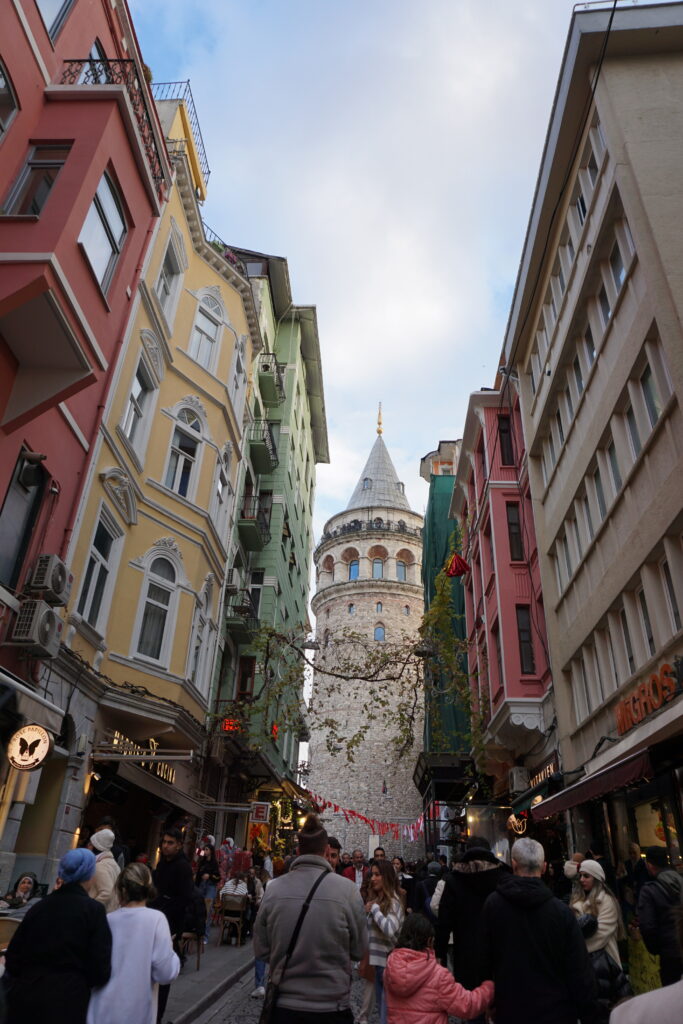
Galata Tower
Explored by Sara of The Abroad Files
The Galata Tower, located in the Beyoglu district of Istanbul, is one of the city’s most iconic landmarks. Built in the 14th century and standing at 67 meters tall, it is considered one of the oldest towers in the world.
Over the centuries, the tower has served numerous roles. It has functioned as a lighthouse, a storehouse, an astronomical observatory, and even a jail. Currently, it operates as a museum and is renowned as the finest viewpoint in Istanbul.
In 1638, a remarkable historical event unfolded from this tower. Hezarfen, a young scientist, crafted a flying suit of feathers and wax. He then used this suit to fly across the Bosporus strait, riding along the wind currents. The event was witnessed by the sultan of the time, who commended the young scientist before banishing him to Algeria. While historians agree the flight was real, many believe the distance has been exaggerated.
The Galata Tower has 9 levels. Visitors take an elevator up to the 7th floor and then a staircase up 2 more floors to an outdoor platform with breathtaking views.
The Galata Tower is open every day from 08:30 to 23:00. I recommend arriving in time for sunset – the best place in Istanbul to watch the sunset and get great photos of the old town.
You can purchase tickets at the booths at the tower’s entrance, or the admission is included with the Istanbul Museum Pass, which also lets you bypass the lines.
The Galata Tower is a special place and a unique experience right in the heart of Istanbul.

Topkapi Palace
Explored by Lavina D’Souza of Continent Hop
Topkapi Palace was built by Sultan Mehmed II in the 15th century, and is another famous Istanbul landmark. For over 400 years, Topkapi Palace housed the most powerful rulers of the Ottoman Empire, and bore witness to the rise and fall of this prominent dynasty.
The palace is located in the Faith district of Istanbul, Turkey. While you can purchase tickets at the entrance to the palace, it is also included on the Turkey and Istanbul Museum Passes.
The architecture of this palace is unlike any other Turkish structure. Every corner of is like a different piece of art. There are beautiful golden arches, tall ceilings covered in unique designs, intricate tilework, and other design elements that photos just don’t do justice.
The important chambers and courtrooms are found at the centre of the monument. The most important rooms are at the peak of the hill, with the Sultan’s room located at the very top. All the buildings and rooms are interconnected by passages and beautiful galleries.
Apart from its architectural importance, the palace contains a museum with extraordinary collections of armour, fabrics, manuscripts and other items belonging to the sultans.
Topkapi Palace is a beautiful example of what Turkey has to offer. It’s the perfect stop to add to a 10 day itinerary in Turkey.
It takes a few hours to casually explore this palace, and more to thoroughly see the museum exhibits. There are four main courtyards, the fourth being the most intimate one where the Sultan lived with his family.
One of the most beautiful sections of the palace is the harem. The harem has 6 floors but only one is accessible to the public. This room is in the Imperial Hall and is full of intricate details and adorned with large mirrors.
For the best experience, visit on Mondays to avoid crowds and purchase the Istanbul Museum Pass to skip the lines.
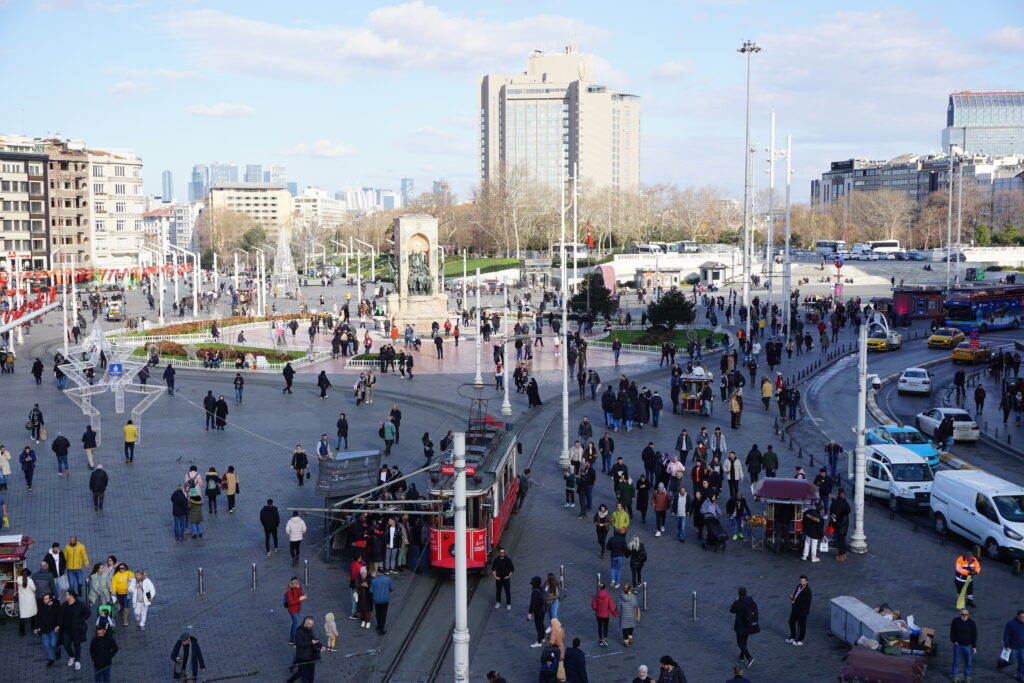
Taksim Square
Taksim Square is a historically and culturally significant site in the city of Istanbul. It has its roots in the late Ottoman era when it was a major transportation hub and served as the endpoint of the historic “Istiklal Avenue.”
Over the years, Taksim Square has witnessed pivotal moments in Turkey’s history, including the proclamation of the Turkish Republic by Mustafa Kemal Atatürk in 1923.
Today, visitors to Taksim Square will encounter a bustling district filled with shops, cafes, and cultural venues. The square itself features the Republic Monument, a symbol of Turkey’s modern identity. Adjacent Istiklal Avenue is a great place for visitors to stroll – it’s famous for its vibrant mix of shopping and entertainment, as well as great eateries.
Beyond its commercial and cultural significance, Taksim Square has become an important gathering ground for local protests and demonstrations. It has been a focal point for various social and political movements, making it a place where the pulse of contemporary Turkish society can be felt. In essence, Taksim Square is not just a place to visit; it’s a dynamic space where Turkey’s past, present, and future converge.
Famous Landmarks in Cappadocia
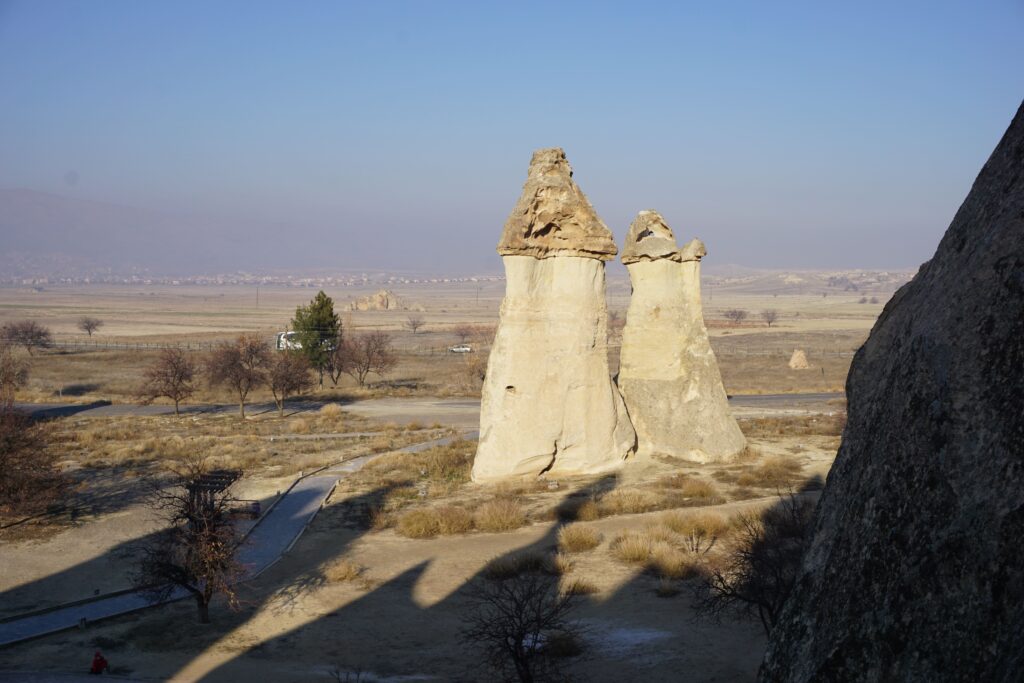
Fairy Chimneys of Cappadocia
Some of the most popular landmarks in Turkey to visit are the fairy chimneys of Cappadocia. These beautiful natural rock formations are the defining features of this Turkish region.
The Cappadocia fairy chimneys were formed millions of years ago when volcanic eruptions rained ash down on this region of central Turkey. This ash then hardened into a tough, porous rock which was subsequently covered by a softer layer of basalt.
Over millions of years, erosion tore away at the basalt layer, leaving behind the existing rock pillars.
The fairy chimneys were further altered when humans moved in. Over millennia, settlers carved into the fairy chimneys to create homes, forts, and churches. Today, you can hike through the valleys of Cappadocia and find remnants of human inhabitance everywhere.
While hiking is a great way to get up close with the fairy chimneys, they are best seen from above on a hot air balloon ride. Air balloon rides depart daily from Goreme, even during winter in Cappadocia. The surreal experience of gliding above the fairy chimneys and seeing the other-worldly Cappadocia landscape from above is one of the many experiences that make Cappadocia worth it.
Be sure to book your air balloon ride in advance as this popular experience is in high demand!
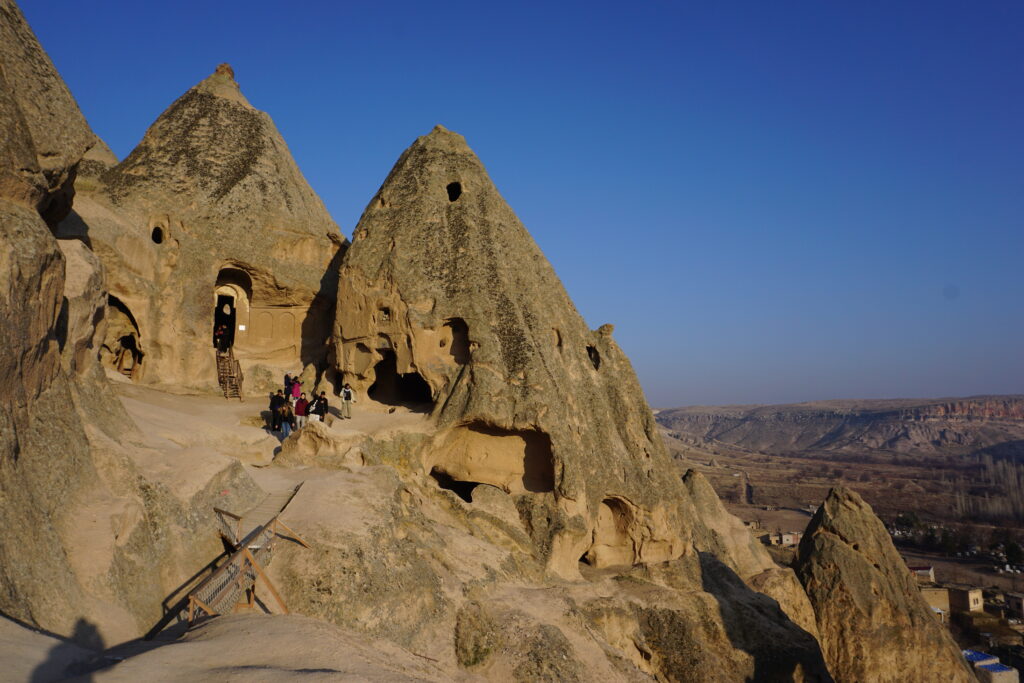
Selime Monastery
This intriguing historical site was once a religious retreat and monastery. Today, Selime Monastery is an interesting and enjoyable place to explore, with its well-preserved rock-cut rooms, tunnels, and chambers that visitors can wander through freely.
The labyrinthine passages and impressive architecture of the monastery is captivating, and some rooms are so dark you’ll need flashlights to navigate through them. It’s a place where you can let your imagination take over as you wander, picturing the daily routines of the monks who once called it home.
Selime Monastery is also a fun stop when visiting Cappadocia with kids, but be sure to keep a close eye on them as there are steep dropoffs and no barriers.
The best way to visit Selime Monastery is via a guided tour. The Green Tour, one of the most popular highly rated tours in the area, stops at the monastery.
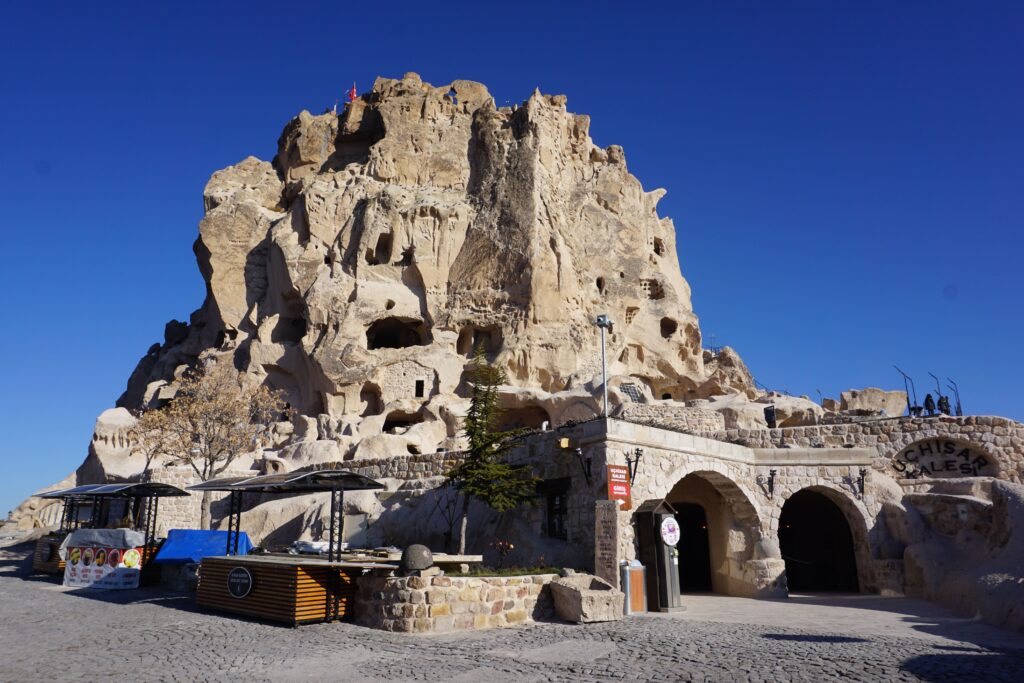
Uchisar Castle
Uchisar Castle is an ancient fortification carved into a massive rock formation in the heart of Cappadocia. The castle has served various purposes throughout its history, including as a fortress and a place of shelter for locals during times of conflict.
Today, a visit to Uchisar Castle offers a unique perspective on the region’s history and beautiful panoramic views of the surreal landscapes. Visitors can explore the winding tunnels and chambers carved into the rock as they make their way to the top. The highest point of Uchisar Castle provides stunning vistas of the surrounding valleys and fairy chimneys, making it a popular spot for photography and sightseeing.
While the castle itself lacks extensive interior decoration or signage, its significance as the tallest fortification in the region and the breathtaking views it offers make it a worthwhile stop for those exploring the wonders of Cappadocia.
The castle is located in the town of Uchisar, a five-minute drive from Goreme. If you’re staying in Goreme, the best way to get to Uchisar Castle is to rent a car and drive.
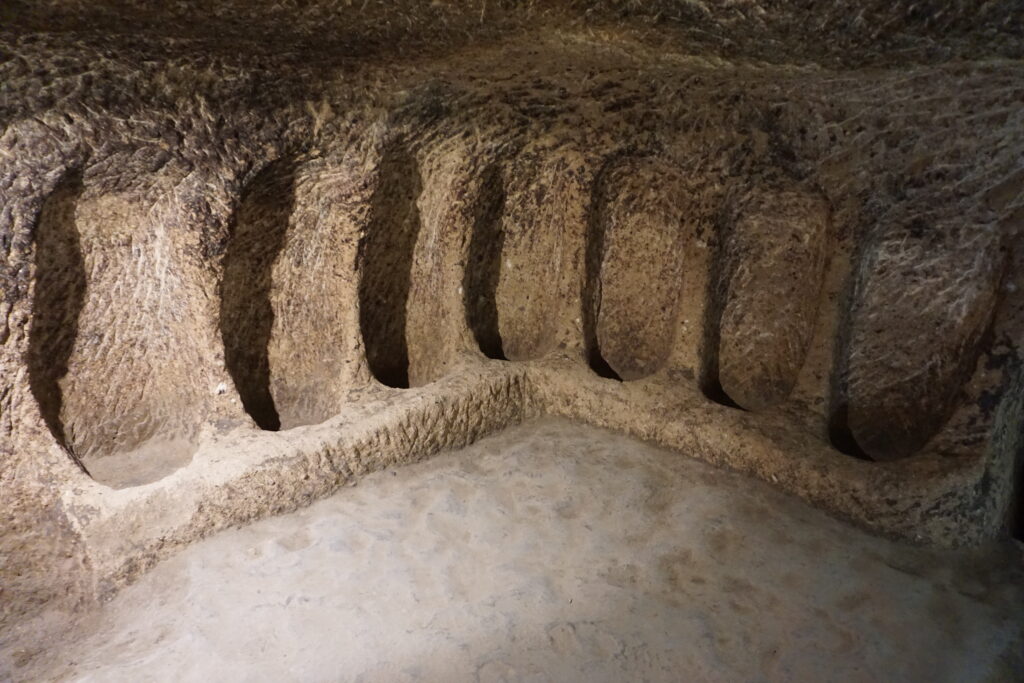
Underground Cities
The underground cities of Cappadocia are some of the most famous historical landmarks in Turkey. The origins of these impressive structures are a bit of a mystery, but references to them have been found in writings dating all the way back to the 5th century BCE.
Excavations of the underground cities have provided insight into their history and purpose. In some, archaeologists have found Hittite artifacts suggesting they may date as far back as 1800 BCE. They’ve also found evidence that the original underground networks were expanded by early Byzantine Christian settlers. These settlers used the subterranean rooms as churches and hiding places to avoid persecution from hostile Persian and Arab armies.
Two of the most visited underground cities are Kaymakli and Derinkuyu. Of the hundreds of underground cities that have so far been unearthed, Kaymakli is the largest in terms of spread, while Derinkuyu is the deepest with 8 levels.
Whether you choose to visit Derinkuyu or Kaymakli, you’ll see many interesting features built to support life in the underground cities. There are animal stalls, storage facilities, kitchens, wineries, and latrines. Air shafts, disguised as wells, provided fresh air for the inhabitants.
The best way to visit the underground cities is via a guided tour so you can learn about the incredible history and construction of these mysterious cities.
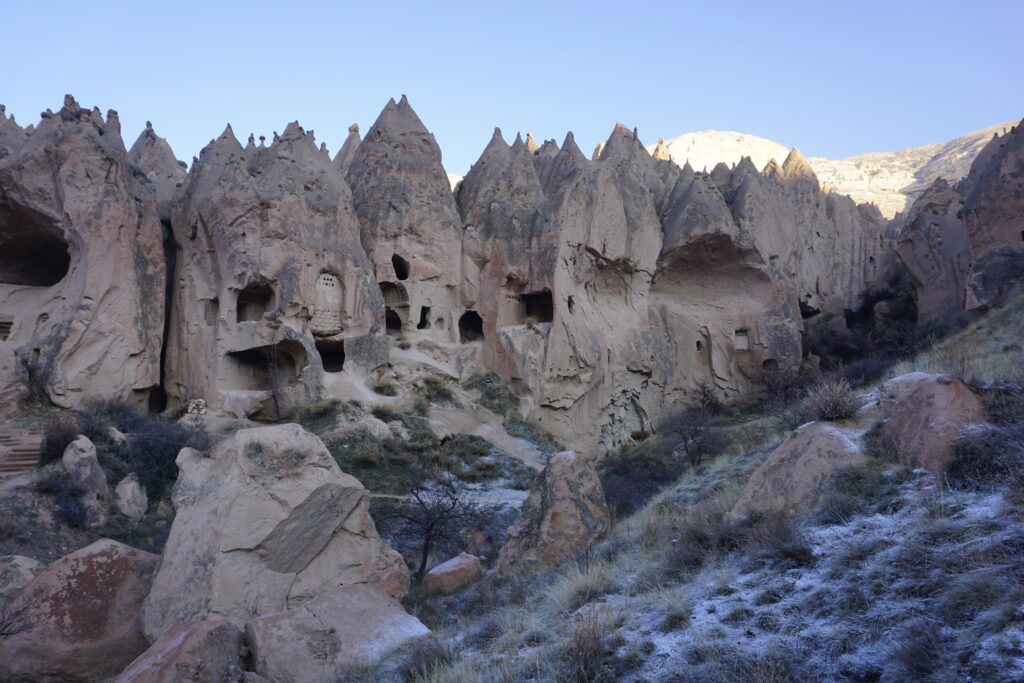
Cappadocia Cave Houses
The Cappadocia region in central Turkey is home to some of the most unique landmarks in the country: cave houses. With a history dating back centuries, these unique dwellings, carved into the soft volcanic rock, offer a glimpse into the area’s rich historical and geological heritage.
One of the best places to see the cave houses is at the Zelve Open Air Museum. Just a short distance from the town of Goreme, this treasure trove of ancient cave dwellings, churches, and pigeon houses boasts the highest concentration of cave houses.
Visitors to the Zelve Open Air Museum have a chance to explore a network of rock-cut dwellings that was once a thriving community – up until the 1950s! Locals lived in these rock houses for generations before they were relocated to the nearby town of Zelve. Centuries of erosion to the soft, porous rock made the dwellings unsafe to live in, forcing locals to move and ending a long-standing way of life.
Another place to experience the cave houses of Cappadocia is in the town of Goreme. In fact, a unique opportunity awaits travelers: the chance to sleep in a cave hotel. Many of the best cave hotels in Goreme have been converted from original homes. Today, they carry all the modern comforts and conveniences of a five-star hotel, while still providing visitors with the truly one-of-a-kind experience of sleeping in a cave.
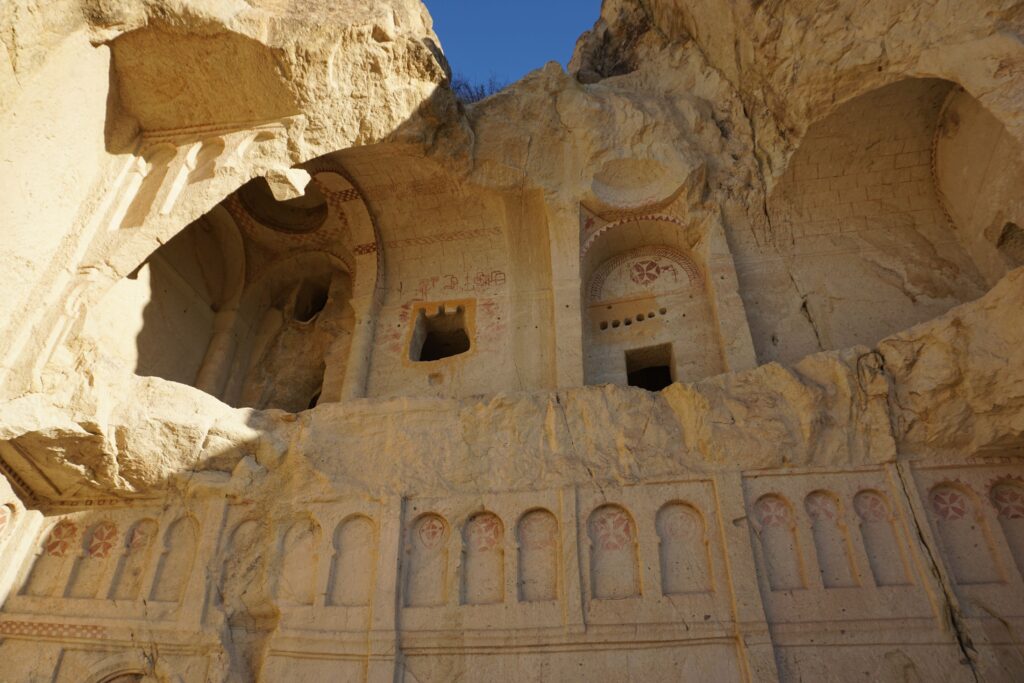
Byzantine Rock Churches
The Byzantine Rock Churches of the Goreme Open Air Museum are important and famous historical landmarks in Turkey. These rock-hewn churches have withstood the test of time, and visitors can see the original frescoes that have been preserved for hundreds of years.
The Goreme Open Air Museum became a UNESCO World Heritage site in 1985, highlighting its importance as one of the top historical landmarks of Turkey.
This remarkable collection of Byzantine Rock Churches is a highlight of visiting Turkey, and certainly not to be missed!
Natural Landmarks in Turkey
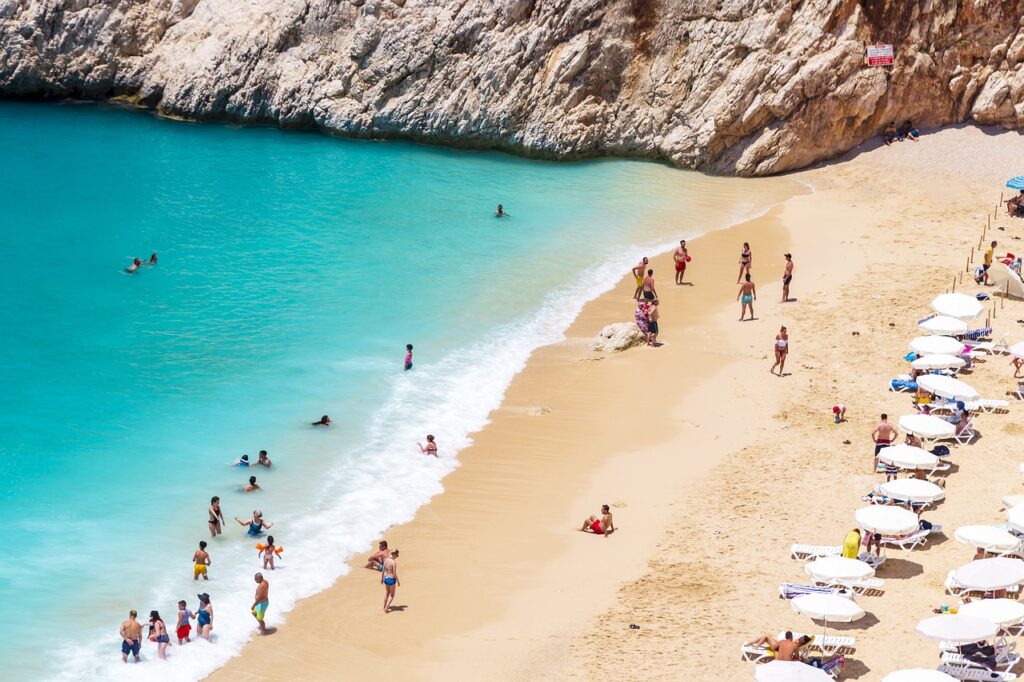
Kaputas Beach
Kaputas Beach sits along the Turkish Riviera, just 20 kilometers west of Kas. This popular and famous beach is touted as one of the best beaches in the country, and for good reason! With its vibrant blue waters and pristine white sand, Kaputas Beach is a true gem of the region.
The beach’s clear, inviting waters make it an ideal spot for swimming and sunbathing. The surrounding steep cliffs create a dramatic backdrop and provide a sense of seclusion, adding to the allure of this popular beach.
Kaputas Beach has rightfully earned its reputation as a popular beach destination in southwest Turkey. Whether you’re looking for relaxation or adventure, the beach’s tranquil ambiance and stunning vistas make it a must-visit spot for those exploring the turquoise coast in southern Turkey.
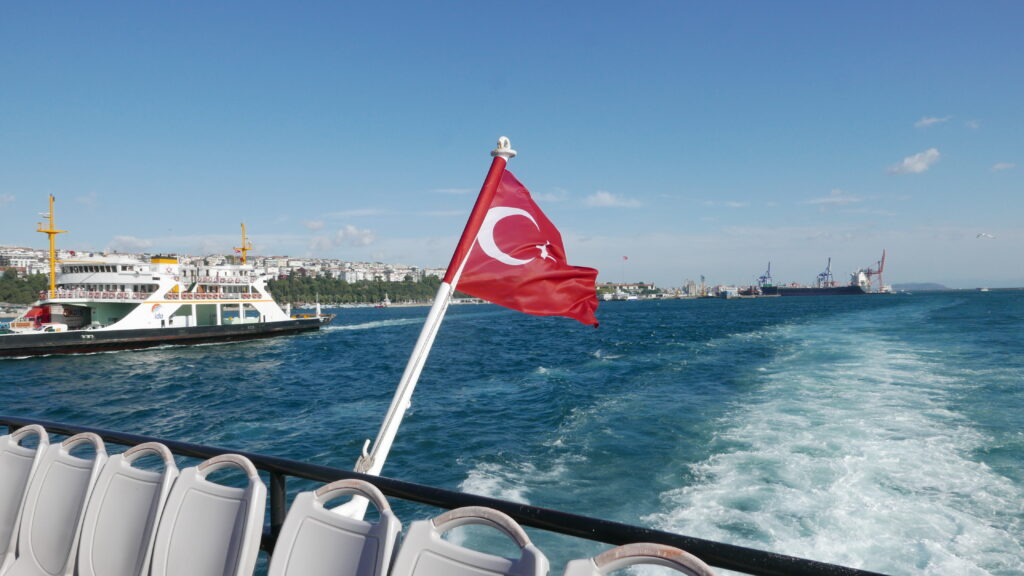
Bosphorus Strait
Explored by Goya of GoyaGaleotta.com
The Bosphorus Strait, a majestic marvel uniting Europe and Asia, stands as a testament to Turkey’s historical, natural, and cultural heritage. Flowing gracefully through Istanbul, this waterway weaves tales of civilizations past, shaping the city’s essence.
As ships traverse its cobalt waters, the Bosphorus whispers stories of empires and conquests. From Persians to Ottomans, it witnessed history unfold. Today, it remains a bustling trade route, uniting cultures and continents in its embrace.
The Bosphorus paints a breathtaking picture, adorned by palaces and mansions that mirror its opulent history. Modernity takes shape in the Bosphorus bridges, engineering marvels connecting two worlds. To cruise these waters is to become part of Istanbul’s heartbeat.
Ferries waltz across, revealing Istanbul’s microcosm—commuters, travelers, and lovers converge, sharing space and stories. The skyline narrates the journey, the past fused with the present. To embrace Turkish authenticity, savor a freshly baked simit and çay, sipped as the vessel carries you — a key to experiencing Istanbul like a local.
Walking the Bosphorus, especially around Bebek and Arnavutköy, unveils more splendor. Serenity merges with the shoreline, a tranquil escape, whether covered in snow or basking in sunshine. And then there’s savoring—a meal by the Bosphorus, on either side, is a feast for senses and stories.
Within Turkey’s mosaic, the Bosphorus Strait threads significance—history and nature in embrace. Cultures converge, inspiring poets, dreamers, wanderers. To explore Turkey’s essence is incomplete without a voyage along the Bosphorus—an ode to Istanbul’s very soul.
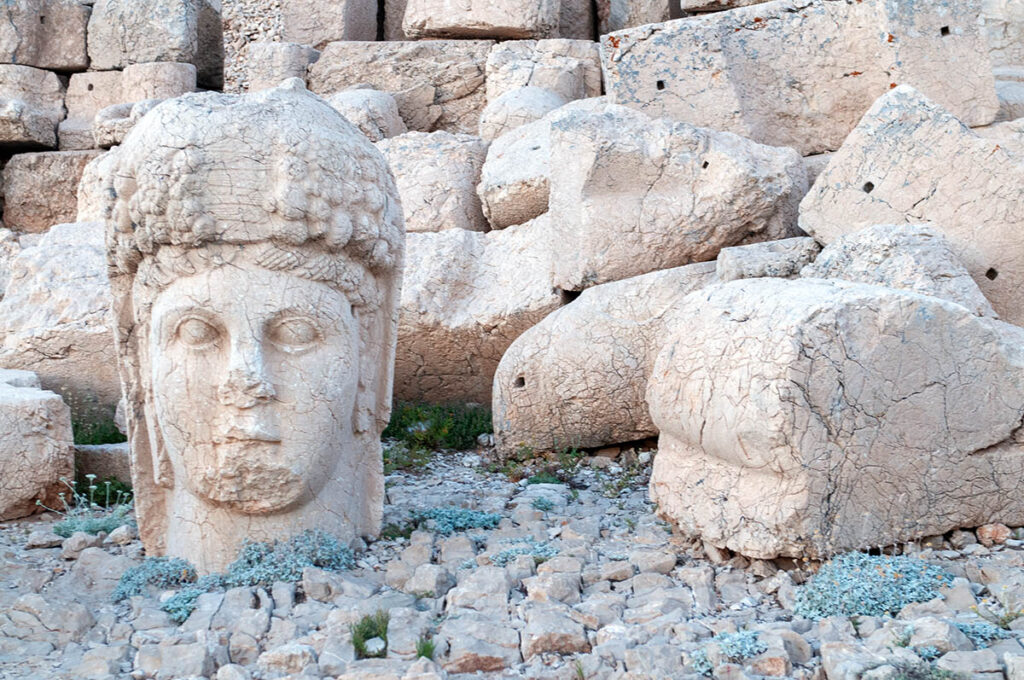
Mount Nemrut
Explored by Anwar of Beyond My Door
Located in Eastern Turkey, Nemrut Dağ (Mount Nemrut) is one of the most interesting and unique places in Turkey to explore. The mountaintop is puzzlingly covered with an array of giant stone heads. Believed to date back to the 1st century BCE, the temple and mountaintop area are thought to have been built during the reign of King Antiochus I of Commagene. The mountaintop has a “false peak,” which is a mound of stones at the top which was used to protect the tomb from robbers.
Many of the statues have been relocated from their original location, and damage to the statues suggests they fell prey to adherents of iconoclasm (belief in the destruction of icons). The world heritage site is one of the many important historical places in Turkey, providing insight into the ancient, lesser-known kingdom of Commagene.
The closest town for visitors is Adiyaman in eastern Turkey. The town is well-connected by bus to the nearby towns of Gaziantep and Sanliurfa, and many travelers pair a trip to Mount Nemrut with visits to Sanliurfa.
You can get to Nemrut by taking a guided tour from Adiyaman, or on your own by renting a car. Those choosing to use a tour should take note of times, as late returns may likely miss any connecting buses back to Sanliurfa/Gaziantep.
The best time to visit Mount Nemrut is from late spring to early fall for the best weather and long daylight hours. Winters in this region are very cold, with heavy snowfall in the higher elevations.
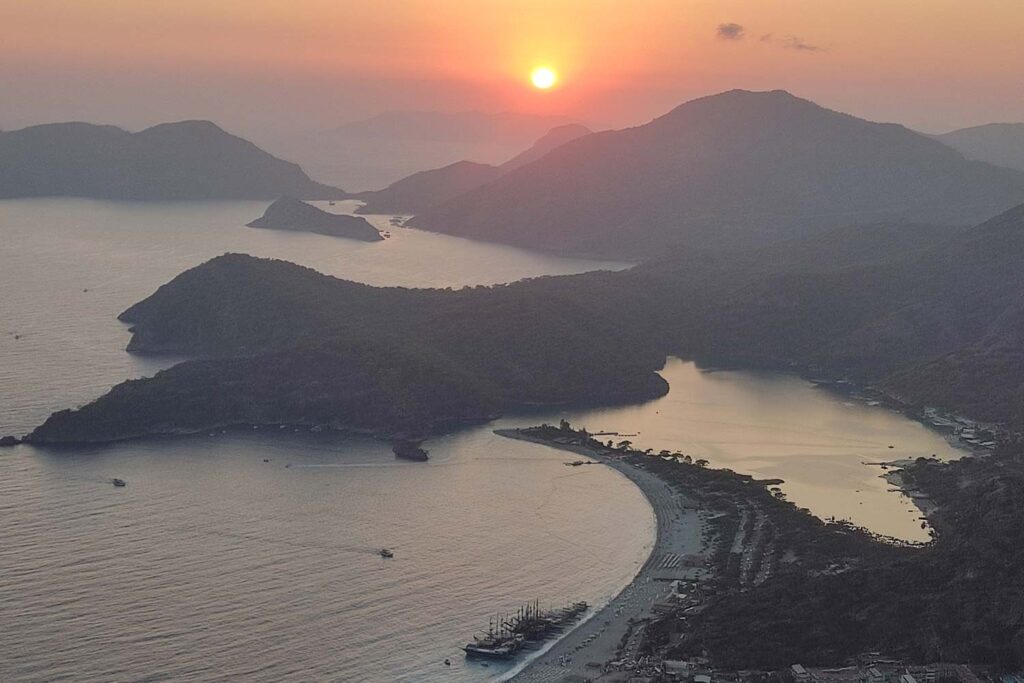
Blue Lagoon
Explored by Sean of The Turkey Traveler
Blue Lagoon, otherwise known as Ölüdeniz, is an extraordinary natural landmark on the Southern Coast of Turkey. It became one of the most popular beach destinations in Turkey thanks to its serene atmosphere, soft sandy beaches, and waters that display a beautiful spectrum of blue hues. The Turkish name “Ölüdeniz”, translates to “Dead Sea” in its English translation, and is derived from the salty calm waters of its hidden lagoon.
Situated approximately 9 miles south of Fethiye in the Mugla District of Turkey, the Blue Lagoon is the perfect place to swim on a hot summer day. The lagoon empties out into the Mediterranean Sea, and the whole area surrounding it is perfect for swimming, sunbathing, or participating in one of the watersports available. There are many stunning beach resorts too if you don’t mind splurging for a nice holiday!
Paragliding is one of the most popular things to do in Oludeniz. Matter of fact, it is regarded as one of the best places in the world for paragliding, thanks to the elevation in which you jump off. Make sure you reserve your tour in advance to secure your spot.
To reach Ölüdeniz Beach, you can take a bus from Fethiye Erasta Mall which is just a short walk from the bus station. The bus from Fethiye to Oludenix Beach operates every 5 minutes, and the journey takes about half an hour. The view from the minibus is quite gorgeous so make sure you look out the window!
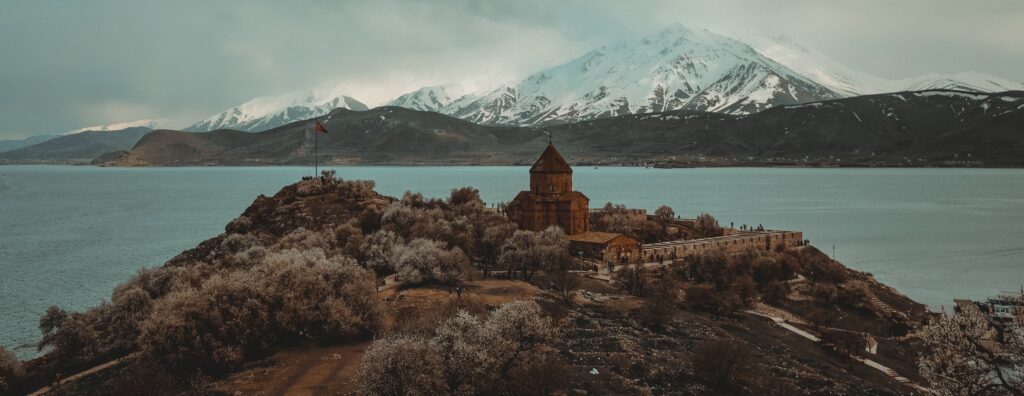
Lake Van
Lake Van is the largest lake in Turkey and one of the most incredible natural wonders in the country. It also holds historical significance – it was the center of the Armenian Kingdom of Urartu and has seen Romans, Seljuks, and more cross its shores. Remnants of these ancient civilizations can still be explored in the region.
One of the many features that make Lake Van unique is that it is one of the few lakes in the world with no outlet. It’s also the largest saltwater lake in the world and the second-largest lake in the Middle East.
Today, many visitors come to this part of south-eastern Turkey to visit Akdamar Island, famous for its 10th-century Armenian church adorned with intricate stone carvings. There are also many opportunities to swim and boat along the lake, as well as hike the surrounding mountains.
Lake Van is one of the most stunning natural landmarks in Turkey and offers an alluring combination of natural beauty and historical intrigue that will appeal to the most adventurous of travelers.

Manavgat Waterfall
Though only a few meters tall, Manavgat Waterfall compensates for its lack of height with an impressive display of power. Spanning the width of the Manavgat River, this waterfall is known for its sheer power, evidenced by the thunderous noise created by the force of the rushing water.
The riverbank is lined with lush green trees, the perfect place for a picnic and family outing. It’s an inviting place to relax and enjoy the natural beauty of the Antalya province of Turkey.
To reach the falls, take a convenient 15-minute dolmus bus ride from the town of Manavgat. If you’re renting a car in Turkey, there’s a free car park located at the entrance to the falls. Manavgat Waterfall is a delightful escape into nature and a great place to go in Turkey for families.
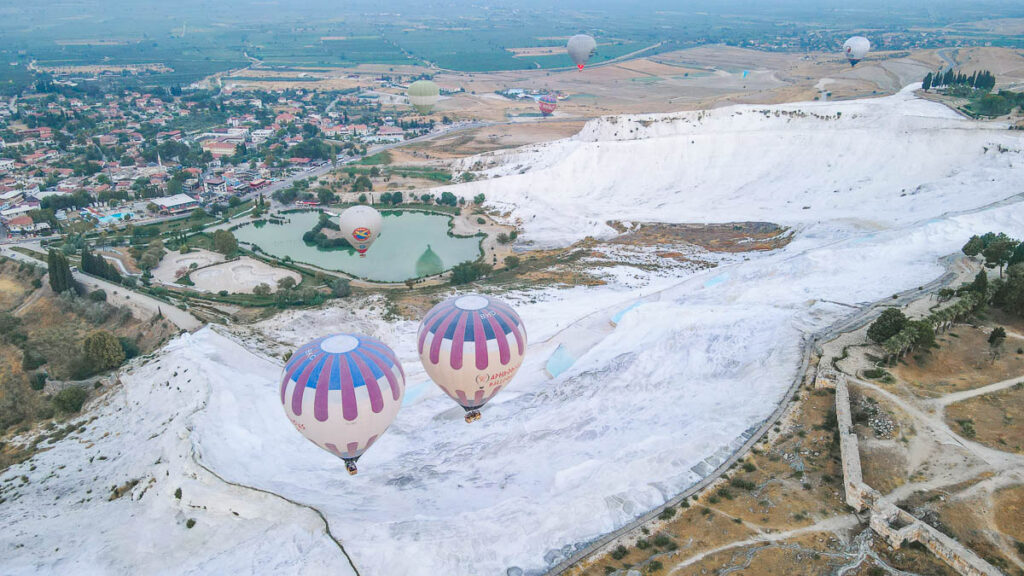
Pamukkale
Explored by Cathrine of Nomadicated
Pamukkale, which means “cotton castle” in Turkish, is one of those incredible postcard landmarks of Turkey. You might mistake it for snow-covered mountains with its white travertine terraces stretching across the hillsides, but these terraces are actually formed by calcite-rich hot springs.
Located in Denizli Province, in southwestern Turkey, Pamukkale is the result of countless years’ accumulation of calcite-laden waters flowing from the cliff’s springs. The landscape is complete with milky blue pools. People have been visiting this area for centuries, believing in the healing properties of its waters.
Visitors to Pamukkale can stroll around the hot springs and travertines, accessible by walking up a large staircase carved into the mountain. Entrance tickets include the UNESCO World Heritage Site, Hierapolis, an ancient Roman spa city. Here, you can find ruins from a 6th-century BC Roman baths, a necropolis, and a theater.
Be prepared for a lot of walking if you plan to see both sites, so wear comfortable shoes and bring water. Many optional activities are also available, like sunrise hot air balloon rides, parasailing, and swimming in Cleopatra’s pools.
The site is most easily accessible from Pamukkale or the nearby city of Denizli; however, many Pamukkale tours begin in Antalya as well, a popular beachside tourist city.
Spring is the best season for Pamukkale, as the summer heat causes the spring water to dry up for much of the year, but the site is open year-round and you can even visit Pamukkale in winter. Given its popularity among tourists, arrive at sunrise to avoid the bulk of the crowds. Plus, you get an incredible view of the floating hot-air balloons.
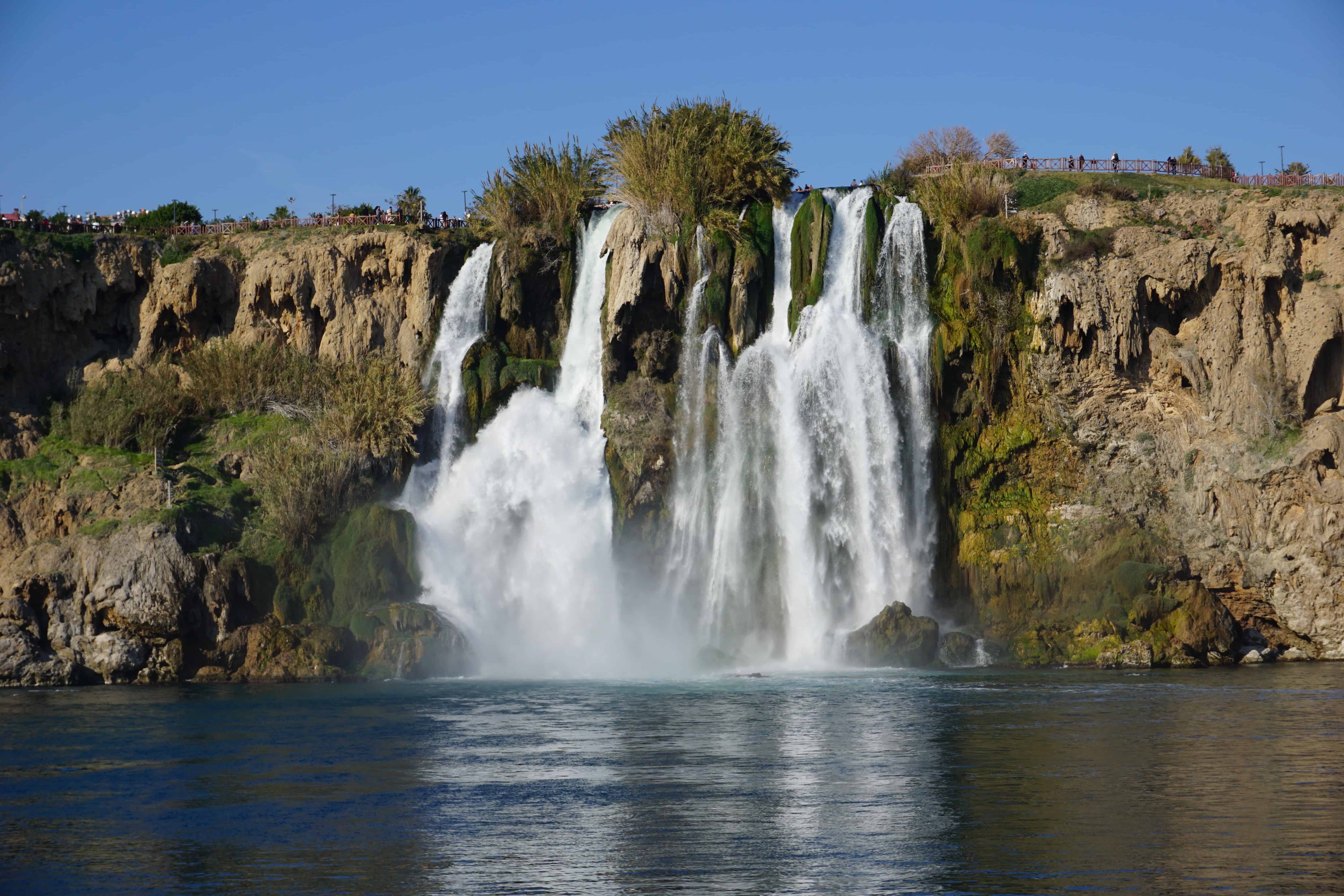
Lower Duden Falls
The seaside city of Antalya boasts one of the best natural Turkish landmarks: Lower Düden Waterfall. What makes this particular waterfall so special and unique is that it flows directly into the Mediterranean Sea.
The best way to see the falls is by taking a boat ride from the old Antalya harbor. The trip takes about an hour each way. Along the way, you’ll enjoy magnificent views of the Mediterranean and can refresh yourself with some Turkish beverages.
Another way to see Lower Duden Falls is from a viewing platform next to the falls. While this will get you closer to the waterfall, you won’t be able to fully appreciate the magnificence of it flowing into the sea. I definitely recommend the boat ride instead!
Historical Landmarks in Turkey
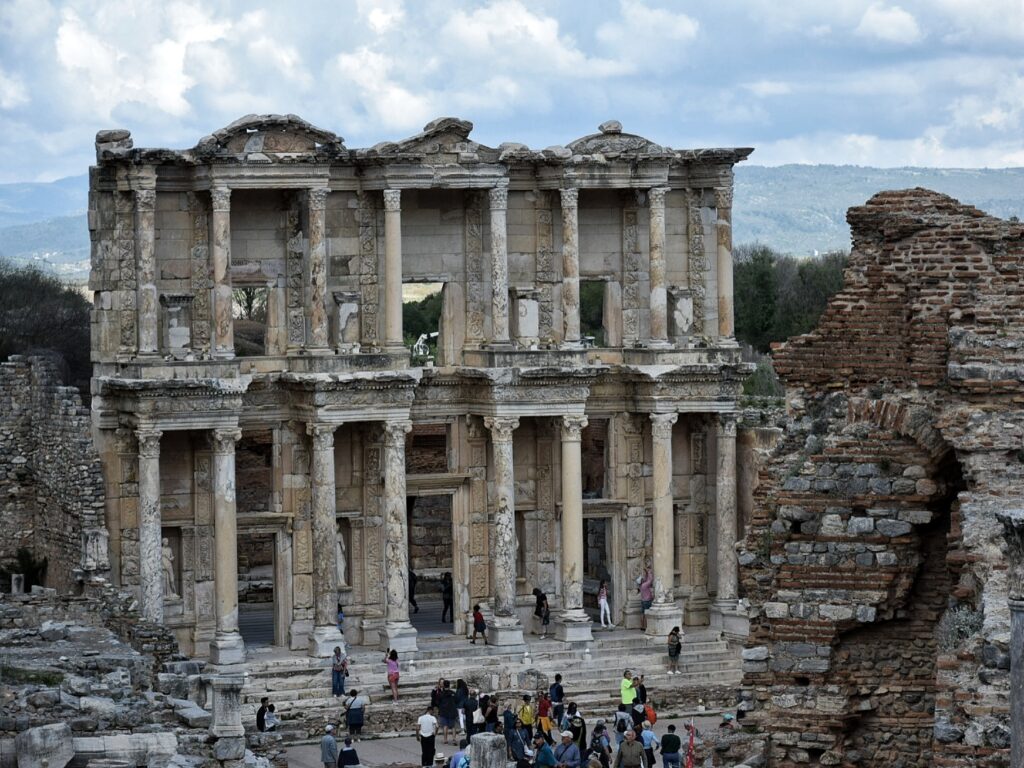
Ephesus
Explored by Claudia of My Adventures Across The World
Ephesus is one of the most impressive archeological sites in Turkey. It used to be a fairly large, important city and the capital of Asia Minor, one of the Roman provinces in this part of the world. More than 250,000 people lived here! The city was first founded in the 10th century BCE, close to an older Greek city.
Ephesus is a widespread site, and it will take you at least half a day to explore it properly. You will be significantly better off hiring a guide that will be able to take you to the main points of interest on the site and give you an overview of the history and significance.
When visiting Ephesus, make sure not to miss the Temple of Artemis (which dates back to the 5th century BCE) and the beautiful Library of Celsus. Other notable places are the Great Theater and the Odeon (another smaller theater); the Winged Nike; the Temple of Hadrian; the Roman baths and the nearby latrines. There is even a set of terraced houses that you can visit (though there is an additional fee for that) that are covered in beautiful, bright frescoes.
There is quite a bit of walking to do on the site, so make sure you wear comfortable shoes. You should also bring a bottle of water with you, as once you are inside there are no fountains for quite some time – there is only a small café near the terraced houses. Some bits of the site are not accessible to people with mobility issues.
You will find Ephesus a few kilometers from the historical city of Selcuk, in Izmir district near Kusadasi. You can access it by car, by bus and on a guided tour.
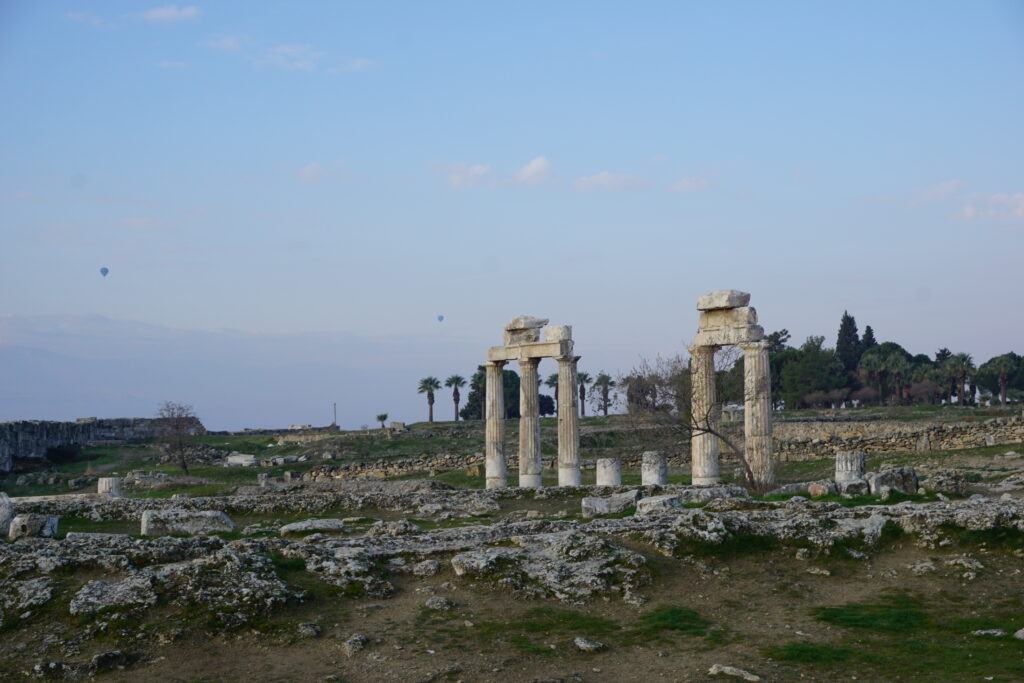
Hierapolis
Hierapolis is an ancient Greek city constructed above the thermal springs of Pamukkale. It’s believed that settlement on this site dates all the way back to the Iron Age. This historical site is sprawled across a large area, taking at least two hours to visit. Because the highlights of the ancient city are so spread out, I recommend renting a golf cart to explore the ruins. While it is pricey (they definitely gouge the prices for tourists!), we found it particularly convenient for us as a family with young children as it allowed us to see the whole site with our kids.
One of the primary attractions within Hieropolis is the Roman theater. Built into the hillside, this is one of the best-preserved Roman antiquities in the world. This grand structure could hold 15,000 spectators, who would cram in to watch plays and political speeches.
Another notable highlight in Hieropolis is the Archaeology Museum, which houses an exceptional collection of remarkably well-preserved Roman sarcophagi. There are also numerous small artifacts on display, spanning a period of 4,000 years.
If you have the time, one of the most iconic experiences at Hieropolis is a swim in Cleopatra’s Pool. This thermal pool remains warm year-round, which means you can even swim here if you visit Pamukkale in the winter! The waters are thought to have healing properties, and Queen Cleopatra herself may have swum here.
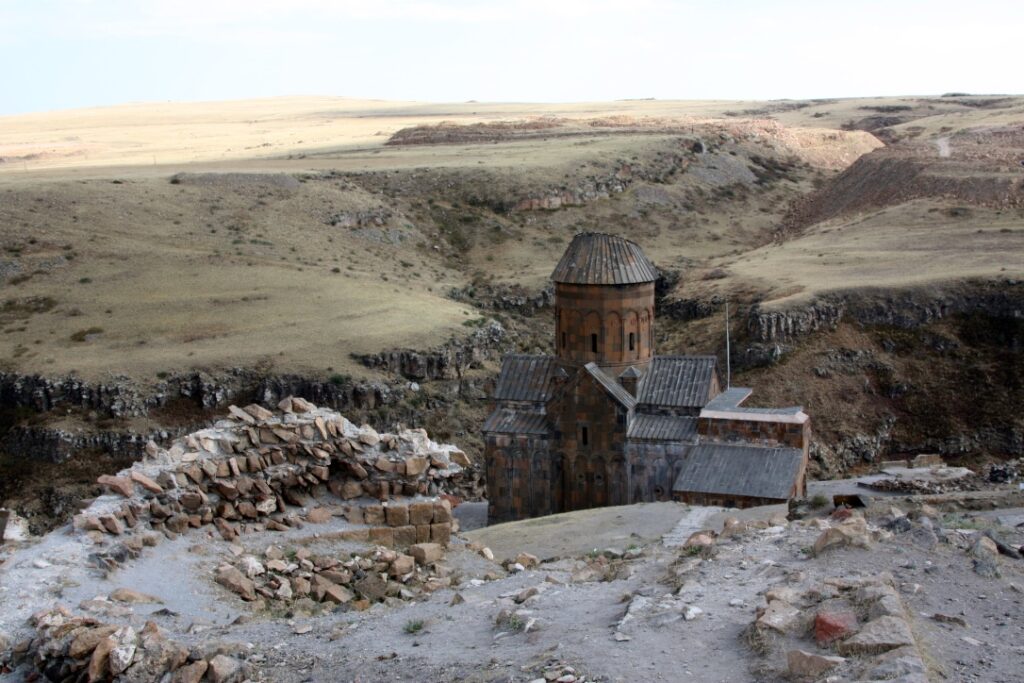
Ruins of Ani
Explored by Candice of Mom in Italy
The ruins of Ani are unique, magical, mysterious, beautiful and eerie – all at the same time.
Located in northeastern Turkey along the border with Armenia, the ruins of the city of Ani are scattered on a grassy plateau and next to a ravine.
Ani was an important city on the Silk Route, and was ruled by countless groups, including Ottoman Turks, Byzantines, Armenians, and Georgians. With a long and complicated history, the flourishing city was devastated by an earthquake in 1319 and saw further decline as the trade routes changed.
The ruins you’ll see now date from the 600s to 1700s CE.
Unlike more accessible ruins around the world, those at Ani have remained relatively untouched (even though they’ve seen their share of looting and have been damaged by earthquakes and weather). So, if you brave the travel to get there, you’ll be rewarded!
Ani is near the Turkish city of Kars, and you can reach the ruins by taking a 40-minute taxi ride. Or, take the direct bus from Kars to the ruins, but your time exploring is limited to when the bus returns.
Once you arrive at the site, you’ll need to pay an entrance fee (a steal for what you’ll see). You can visit the site any day, but note that it’s closed at night.
It’s a UNESCO site now, so it’s being protected, and visits are regulated. But, that doesn’t mean there’s a lot of tourist infrastructure. When I visited there were no facilities or tourist infrastructure. Expect to walk on rocky trails to visit the spread-out ruins.
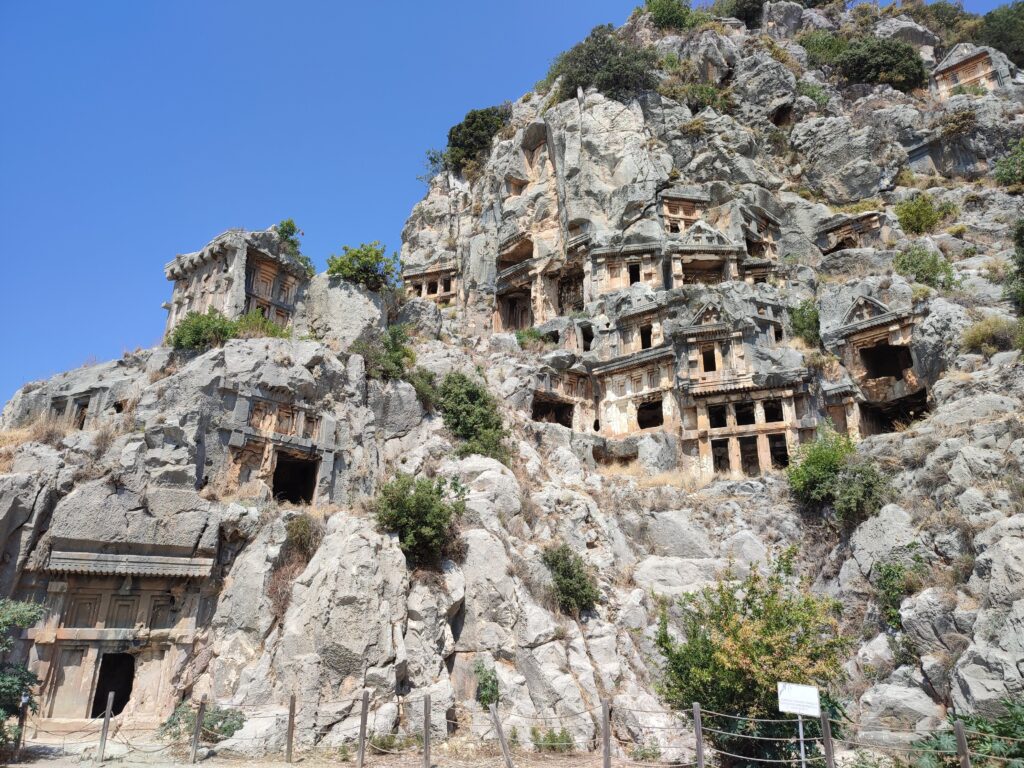
Myra Ruins
Explored by Simon of Backpack Moments
The Ruins of Myra are a testament to the long and ancient history of Turkey’s Aegean coast. Myra was a prominent city and part of the coastal Lycian civilization. The first mentions of the city are from the 5th century BCE. It’s even believed that St. Nicholas was born in this area at the end of the 3rd century CE.
The Church of St. Nicholas, built in the 6th century CE to honor the revered saint, still stands in the middle of the city – today called Demre after a name change in 2006. Was Santa Claus born in Myra? Quite possibly, because Saint Nicholas is indeed the prototype of the jolly old man with the white beard that brings you presents every December.
In Myra you will also see bizarre and exquisite rock-cut tombs that still hold the bones of people from a lost civilization. The huge Roman Amphitheater of Myra still stands intact, reminding visitors of the times when it hosted 10,000 spectators, all citizens of the Roman Empire.
The ruins of Myra are a popular tourist attraction in South Turkey, located 3 hours from Antalya to the east and 1 hour from the resort town of Kaş to the west. You are allowed to enter the ruins and walk inside the Roman Theater, but climbing to the Lycian tombs is strictly forbidden.
The Church of St. Nicholas is an important pilgrimage site for Orthodox Christians and receives hundreds of tourists daily who come on organized tours from Antalya.

The City of Troy
Explored by Erica Riley of Travels With Erica
The Ancient City of Troy is one of the most famous landmarks in the country of Turkey. It’s located 32km outside the city of Çanakkale in northwestern Turkey and is accessible from Çanakkale by bus.
The Ancient City of Troy is one of the most famous archeological sites in the world and is the location of one of the most well-known events of the ancient world: the siege of Troy by the Greek warriors the Spartans and the Achaeans. The site has lived on through history thanks to Homer’s famous retelling of the battle in the Iliad.
Ongoing excavation of Troy has been taking place for over 140 years, with the first excavation started in 1870 by Heinrich Schliemann.
Today, tourists are able to walk through the ruins and learn about the history of Troy and the excavation process. The site is open for tourists from 8:30 a.m. to 8 p.m. every day, with the last ticket being sold at 7:30 p.m.
After visiting the ruins, you can take a short walk to the Museum of Troy and see some of the artifacts that were removed from the site. Entrance to the museum is included with your entry ticket to the ruins. The bus back to Çanakkale picks you up outside the museum, not at the entrance to the ruins, so you need to walk to the museum even if you don’t go inside to visit it.
The Troy ruins aren’t very large, so you only need half a day to visit the archeological site and the museum.
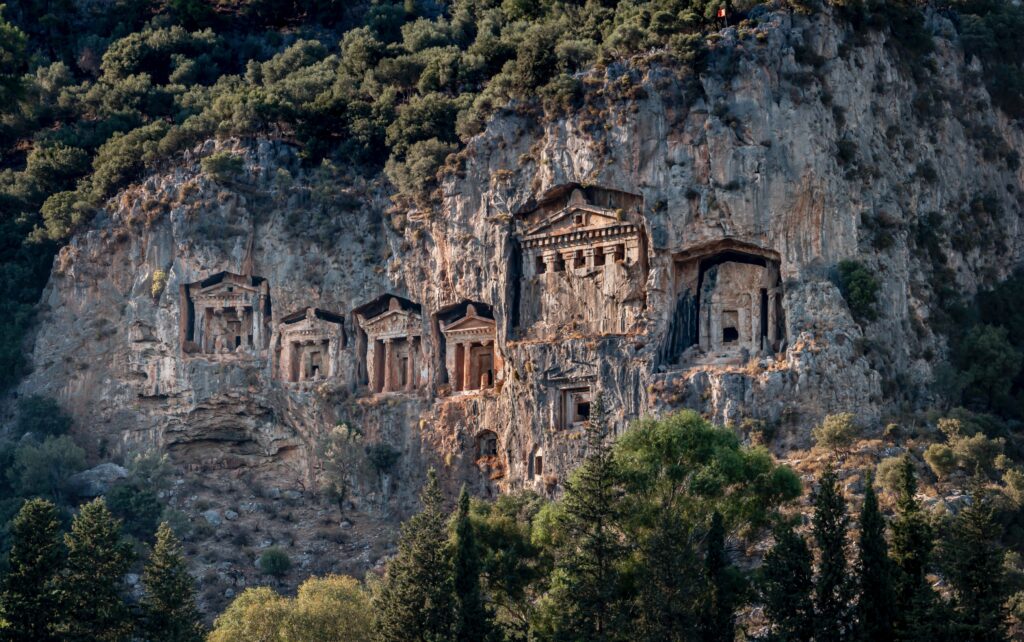
Ancient Tombs of Dalyan
The ancient Lyceum tombs along the Dalyan River are some of Turkey’s best ancient landmarks. The tombs are remnants of the city of Kaunos, believed to have been founded by the Carians in the 8th and 9th centuries BCE.
Over time Kaunos evolved and experienced influences from a large variety of civilizations. Throughout its history, cultures from Persia, Sparta, Rhodes, and more made their way to Kaunos. In the 5th century BCE, the city came under Greek rule before ultimately becoming a significant Roman center.
The temple tombs we see today are part of the Kaunos necropolis, built in the mid-4th century BCE, which once housed over 170 rock-cut graves. The tombs showcase a blend of Anatolian, Greek, and Persian architectural elements.
While the tombs are no longer accessible (they are built high into the rock face overlooking the river), visitors can still enjoy seeing this spectacular spot from afar. The best way to see the ancient tombs is by taking a riverboat tour along the Dalyan River.
Turkey has a treasure trove of ancient landmarks, and these incredible tombs provide a glimpse into the history and culture exchange that has labeled Turkey a crossroads of civilizations for centuries.
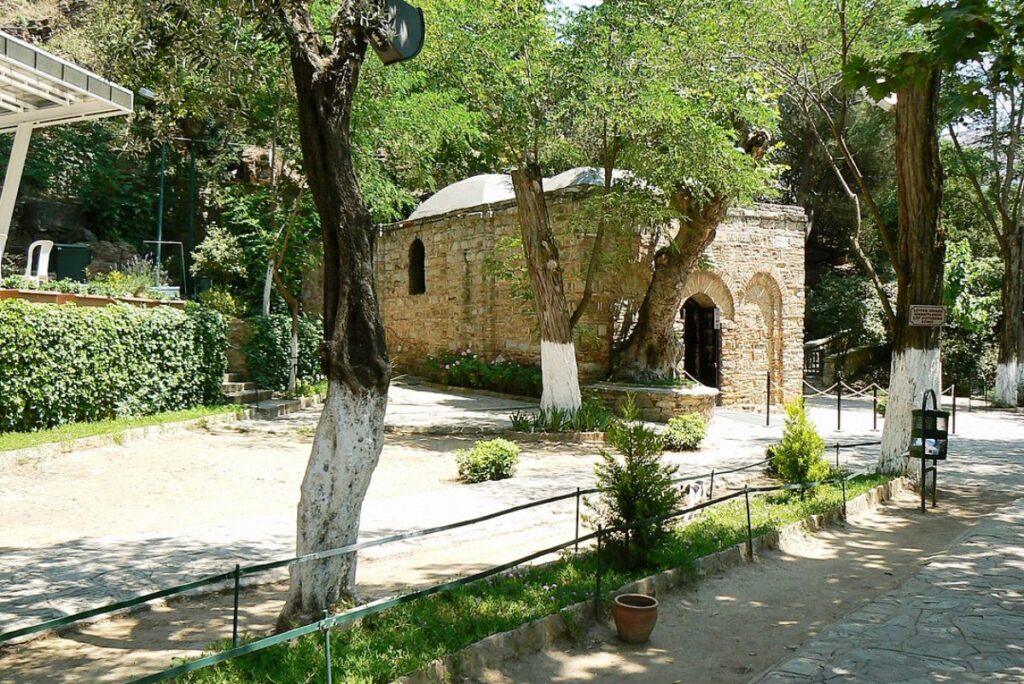
House of the Virgin Mary
Explored by Faith of XYU and Beyond
The House of the Virgin Mary is located on the top of Bülbül Dag (Nightingale Mountain) near Ephesus and is one of the most important Turkish landmarks for Christians. Although not confirmed by the Church, the house is believed to be where Mary was assumed into heaven. It is said that the Apostle John brought Mary to this house after Jesus spoke to him from the cross to take care of his mother.
The house was discovered in the 19th century when the nun Anne Catherine Emmerich had visions of where the house was located. Many years after her death a priest read and followed her descriptions and discovered the final resting place of Mary.
The house was built in the 4th century and is a two-story structure made entirely of stone. There is an anteroom, bedroom, and a prayer room which is considered the Christian Church area. The fireplace room is used as a Muslim Chapel. It is also a sacred place for Muslims since Mary (Meryem Ana) is spoken of in the Quran.
The Catholic Church has never confirmed this to be the place of her assumption, but three popes have visited and worshipped here.
Outside the house, you can visit the Holy Waters where you will see 3 taps. These taps represent fertility, health, and wealth. Nearby is the Water of Mary: a wishing well that is believed to be the source of miracles. Pilgrims tie their personal wishes onto paper or fabric and attach them to the wall behind the well. They then drink from the waters which are said to heal all ills.
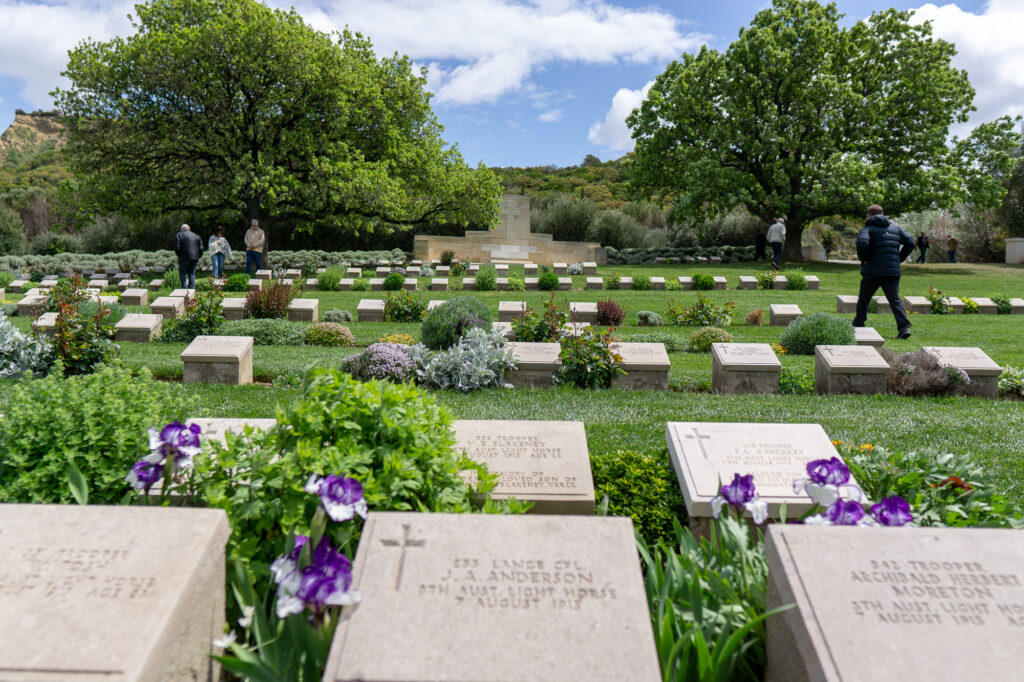
Gallipoli
Explored by Delilah of Travel Sim Expert
Along the coast of western Turkey, the historic peninsula of Gallipoli marks the site where Allied Forces launched an invasion against the Ottoman Empire during WWI. The aim of the campaign was to secure the Bosphorus Strait as a supply route to Russia. However, the campaign was a complete failure, resulting in the estimated deaths of over 100,000 soldiers across both sides.
It was a pivotal campaign during WWI as, if it had been successful, the war would have likely ended much earlier. For Turkey, their victory on this battlefield meant the survival of the country that exists today.
For Australians and Kiwis, visiting Gallipoli is an emotional and important experience. However other travelers should consider visiting due to its importance to the Turkish people as much as for its unsuccessful role during WWI.
Reaching Gallipoli from Istanbul is easy. Kamil Koc, owned by Flixbus, is the best bus company in Turkey and offers frequent routes to Canakkale. Alternatively, if you rent a car, the drive takes about 4 hours. From Canakkale you can take a boat to Gallipoli, but unless you have a car this isn’t the best option as the peninsula is far too big to walk around. Even if you have a vehicle, the sim cards in Turkey have pretty weak coverage in Gallipoli so getting around is difficult and you won’t be able to rely on Google for information on the sights.
I recommend booking a tour with Crowded House. They offer day trips to the Gallipoli Peninsula where you will be guided through the most important locations, including the memorial sites, Chunuk Bair, Lone Pine, and Cape Helles, as well as the critical battlefields and landing spots such as ANZAC Cove.
In addition to this, the nearby city of Canakkale is beautiful and surprisingly lively. Spending a couple of nights here is well worth it before heading down to Troy, Ephesus, and Pamukkale.
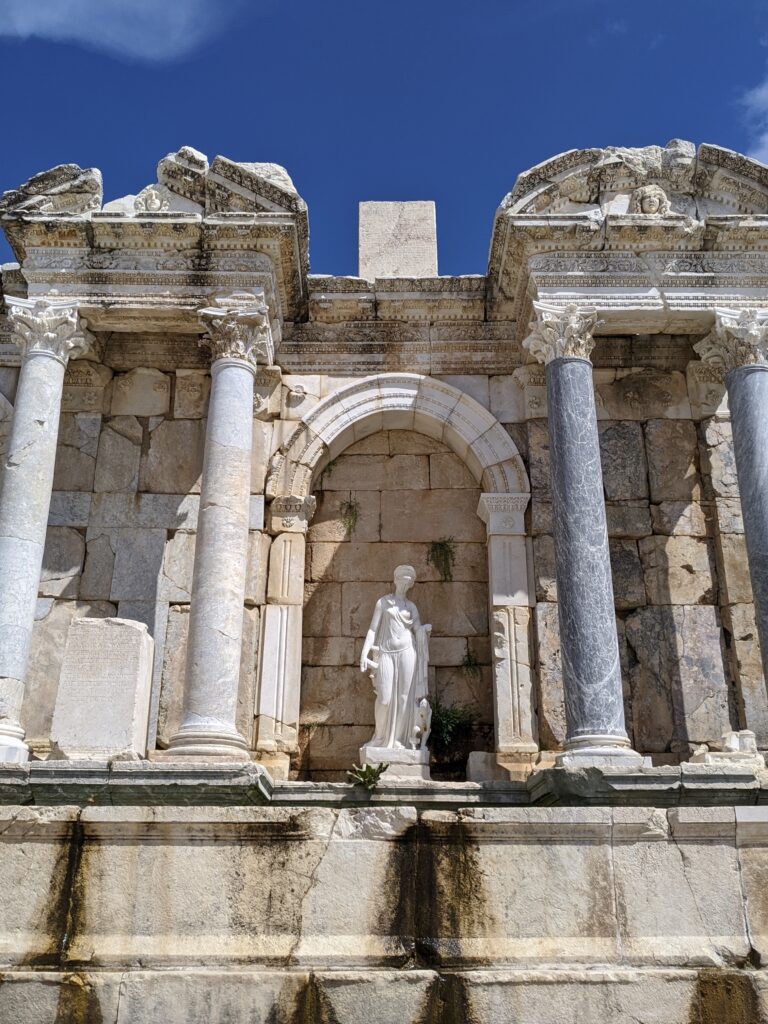
Sagalassos
The ancient city of Sagalassos, perched amidst the jagged peaks of Ak Dag, boasts sprawling ruins that are a testament to the ancient Sagalassian belief in the connection between architecture, nature, and the deities of antiquity. Human settlement here dates back to 8,000 BCE and has hosted Phrygians, Greeks, Romans, and more. Abandoned in the seventh century, archaeologists have been working to excavate and reconstruct the sight since the early 1990s.
What sets Sagalassos apart from many other archaeological sites along Turkey’s Mediterranean coast is its tranquility. Unlike those often crowded with tour buses and groups, Sagalassos is famous for being one of the more peaceful ancient sites.
Your visit begins as you walk in ancient footsteps along the original Roman colonnaded street. Along this path, you’ll encounter well-preserved former fountains adorned with exquisite sculptures of mythic figures such as Nereids and Muses.
The highlight of a visit to Sagalassos is undoubtedly the Antonine Nymphaeum, a colossal fountain complex that stands 9 meters tall and spans 28 meters in width. The Nymphaeum is a testament to the architectural and artistic sophistication of its time, with ornate decorations featuring medusa heads and intricate fish motifs.
Be sure not to miss the Roman Theatre, a historical gem and one of the largest and most complete in Turkey. With a seating capacity of 9,000, it once hosted grand spectacles.
Sagalassos, high up on its mountain perch, is an archaeological treasure that promises visitors a serene and insightful journey through ancient history and culture.
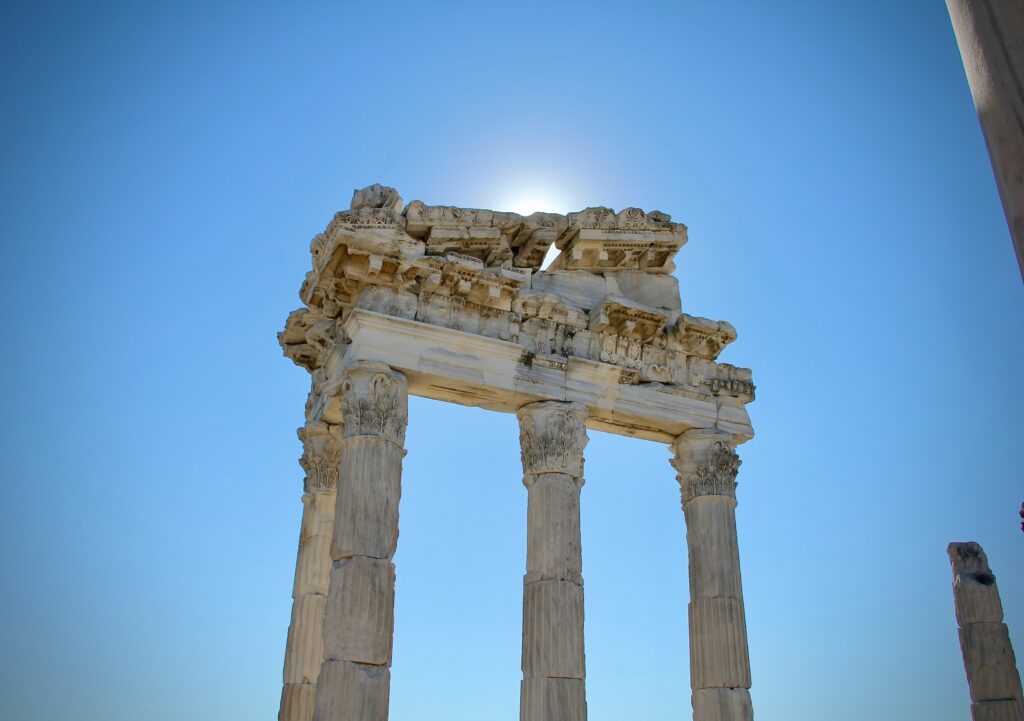
Temple of Trajan in Pergamom
The ancient city of Pergamum, located in the modern-day city of Bergama, owes its historical prominence to Lysimachus, a notable general under Alexander the Great. Situated just 1 km outside the modern town, the Bergama Acropolis in Turkey is one of the most historical and remarkable archaeological sites in the country. Perched dramatically atop a hill to the northeast of the town center, its allure is undeniable.
Amongst the scattering of ancient remnants at this site sits the Temple of Trajan. Constructed during the reigns of emperors Trajan and Hadrian, this temple served as a place of reverence for these rulers and the mighty Zeus. It stands as the sole surviving Roman structure on the Acropolis.
To access this captivating site, follow the signposts along Akropol Caddesi to the lower station of the Bergama Acropolis Cable Car. Here you can park in the paid lot before the five-minute cable car journey up the hill to the Acropolis, where you can wander through the ancient ruins of this Turkish landmark yourself.
While some artifacts from the area can be viewed at the Bergama Archaeological Museum, two heads from sculptures of Trajan and Hadrian are on display at the Pergamon Museum in Berlin, Germany.
Hattusa
Hattusa was the capital of the ancient Hittite Kingdom, which during the Bronze Age spanned an area from the western Aegean Sea and south to Syria. Today, this mountainous and isolated site is home to a population of 15,000.
When you visit Hattusa you can explore the remnants of its defensive walls which encircle the scattered ruins. A comprehensive walk around the site, hitting all the stops along the way, takes roughly three hours. The lower city and temple form a large sprawling complex that dates back to the 14th century BCE. Among the ruins you’ll encounter store rooms once believed to be three stories high.
Another notable thing you’ll see at Hattusa is a large green nephrite rock in the middle of the Grand Temple. This conspicuous rock was likely used for Hittite religious rituals.
For a deeper understanding of the Hittites and to make the most of your visit, I recommend taking a guided tour of the site. This will help you to delve into the rich history of Hattusa and appreciate the significance of this ancient capital.
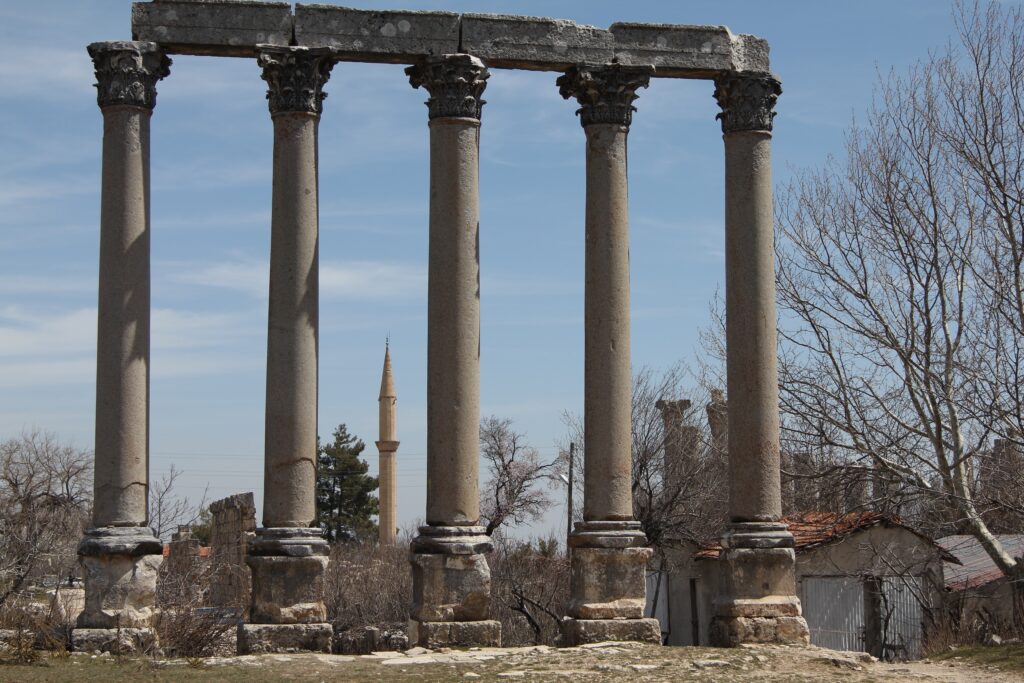
Uzuncaburc
Uzuncaburc is an ancient site containing both Hellenistic and Roman ruins. Originally the Hellenistic city of Olba, it was the sacred place of the Olba people. This religious cult centered around their devotion to Zeus Olbius.
At the heart of Uzuncaburc lies the impressive Temple of Zeus Olbius, marked by two dozen erect columns that have withstood the test of time. Besides this iconic temple, the site contains the remains of a Roman colonnaded street, a nymphaeum dating back to the 2nd century CE, an arched city gate, and a well-preserved Roman theatre with seating for 2,500 spectators.
During the Christian era, many of the temples were converted into churches.
Located approximately 20 miles north of Silifke, Uzuncaburc is a remarkable site showcasing the transition of cultures that defines the history of the region.
Famous Monuments in Turkey
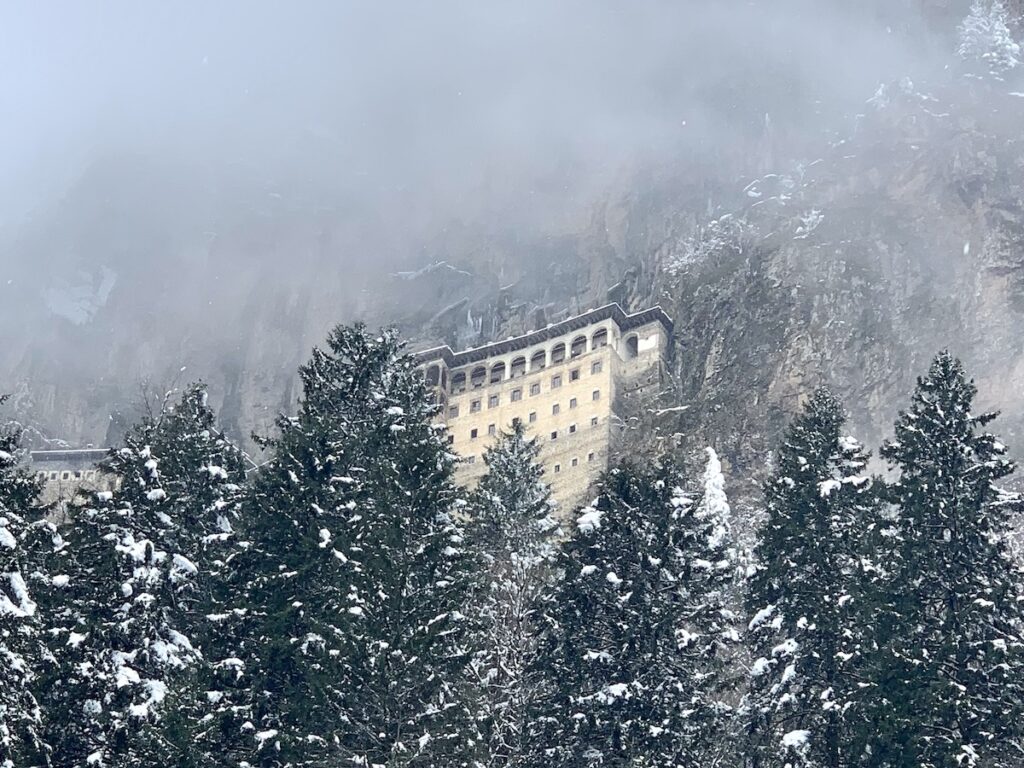
Sumela Monastery
Explored by Kedi of Let’s Travel to Türkiye
Resting dramatically on a steep cliff at 1,200 meters above sea level, Sumela Monastery is, without a doubt, one of the best Turkish landmarks in the Black Sea region.
The monastery’s history goes back more than a thousand years. According to legend, the Virgin Mary appeared in the dreams of two monks (Barnabas and Sophronios) and told them to find an icon in the mountains near Trabzon. After a long journey, the two monks found the icon of the Virgin Mary in a cave and built what is now known as the Sumela Monastery.
The site is significant for religious, cultural, and historical reasons. The monastery continues to draw pilgrims from around the world, especially thanks to the beautiful frescos, various caves (that functioned as rooms for travelers hundreds of years ago), and the Rock Church.
Sumela Monastery is located in the Black Sea region of Turkey, about 50 kilometers from the city of Trabzon. The easiest way to visit Sumela is by renting a car, especially if you add it as a stop in your Black Sea road trip itinerary! Likewise, it is also possible to visit Sumela Monastery by taking a minivan (dolmuş) to Maçka and then another one to the monastery, or by opting for a group tour. Please note that there’s a fairly steep walk up the stairs to the monastery, which might pose a problem to those with knee problems.
The Sumela Monastery is an excellent day trip from Trabzon, and you can easily spend the whole day exploring the area. Walking around and seeing all of the areas of the monastery takes about 2 to 3 hours. If traveling to the monastery by car, you can also continue your trip and visit nearby attractions like Karaca Cave and the Torul Glass Terrace (Torul Cam Teras).
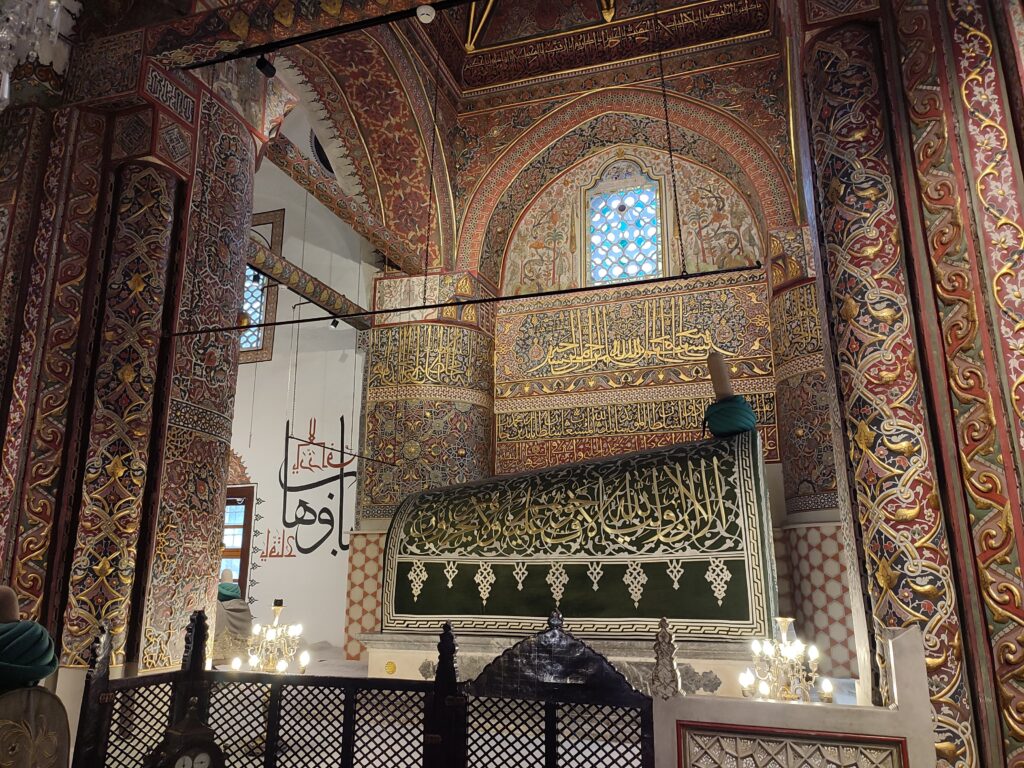
Mevlana Mausoleum
Explored by Simon of Backpack Moments
There once lived a Persian called Rumi, so eloquent in his poetry and so wise in his teachings that a religious order in his name was founded in Turkey in the 14th century. His followers called him “Mevlana,” meaning “Our Master,” and deeply believed in his spiritual take on Islam. The Sufi Order founded in his name in Konya, Turkey, still performs their mystical Sama ceremony to this day.
You might know them under a different name: The Whirling Dervish of Konya.
Mevlana was buried in the Dervish Lodge in the city of Konya. Today the lodge is a museum that still houses his tomb. The elegant architecture of the mausoleum features an impressive bright turquoise dome, intricate calligraphy unlike anything else in Turkey, and a serene courtyard. Inside lies Mevlana’s final resting place, adorned with a beautiful wooden catafalque with golden inscriptions.
The Mevlana Mausoleum is a very popular pilgrimage site for Muslims who come to remember and reflect on Rumi’s teachings of love, unity, and spiritual enlightenment. Visitors will find an extensive collection of manuscripts, artifacts, and musical instruments, as well as memorabilia from Rumi’s life that speaks to his enduring influence on Islamic mysticism and poetry.
To make your visit to the Mevlana Mausoleum complete, make sure to go to Konya on a Saturday in order to witness the Sama ceremony of the Whirling Dervish in the nearby Mevlana Cultural Center. Konya is well connected to Istanbul, Ankara, and Antalya by regular trains, buses, and daily domestic flights.
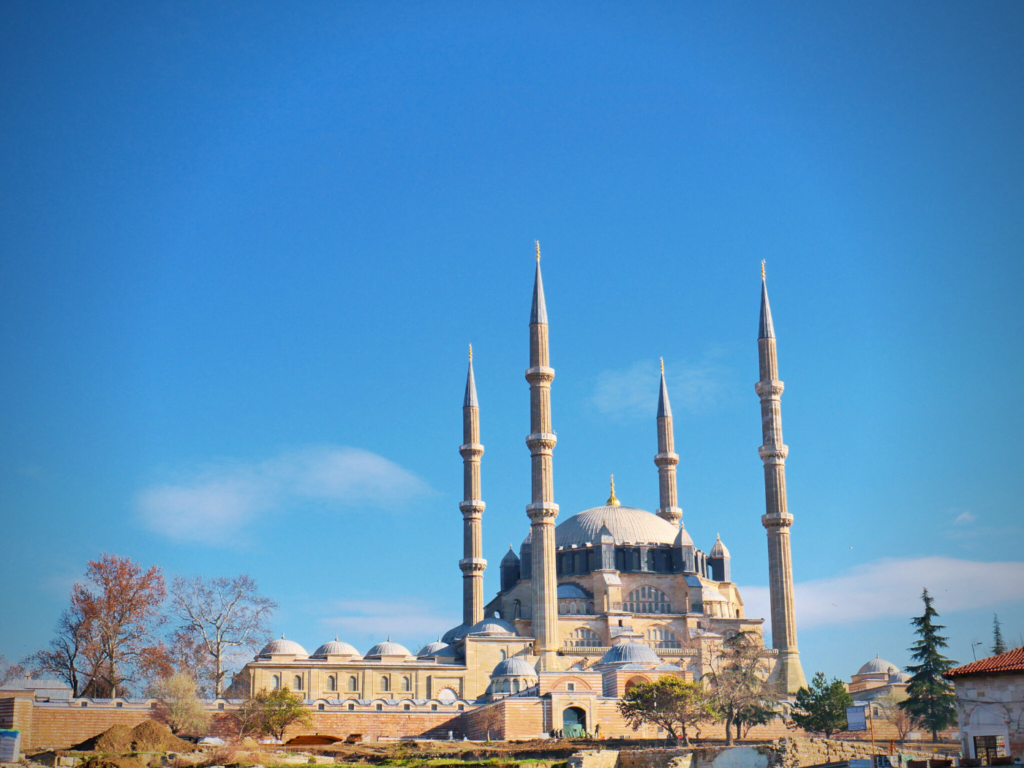
Selimiye Monastery
Explored by Iris Veldwijk from Mind of a Hitchhiker
One of the true architectural wonders of the Ottoman period is Selimiye Mosque in Eastern Thrace. It is in this city that the most beloved imperial architect, Mimar Sinan, completed his unsurpassed masterpiece in 1575. Though he had many apprentices who continued to design famous structures in the Ottoman style – such as the Blue Mosque and the Mostar Bridge – none of them advanced the craft the way Sinan did.
Before the fall of Constantinople in 1453, Edirne was the Ottoman capital for 84 years. More than a century later, Sultan Selim II ordered Mimar Sinan to build his imperial mosque that would bear his name in this city. Why Edirne was chosen over Constantinople (Istanbul) remains unclear.
To visit this symbol of Edirne and UNESCO World Heritage site, just ask for ‘Selimiye Camii’ or ‘Edirne Meydan’ and someone will point you in the right direction. As a non-Muslim, follow basic courtesy rules, the same for visiting any mosque in Turkey: come between prayer times, take off your shoes, and wear modest dress. Women must also cover their hair with a scarf or hood.
It’s lovely to just hang out in the mosque, its garden, and the small museum and see how this nearly 500-year-old place of worship is still at the heart of the community. The mosque is open every day from morning prayer to evening prayer, so that’s usually between 6:30 and 20:30.
While visiting Edirne, make sure to also visit the Bayezid II social complex with its excellent health museum. On the way, you’ll cross many wonderful Ottoman bridges and gain a good view of Selimiye Mosque from afar.
Edirne is less than four hours west of Istanbul on the European side of Turkey. It’s very close to the borders with Greece and Bulgaria, to which there are also excellent connections, mostly by bus.
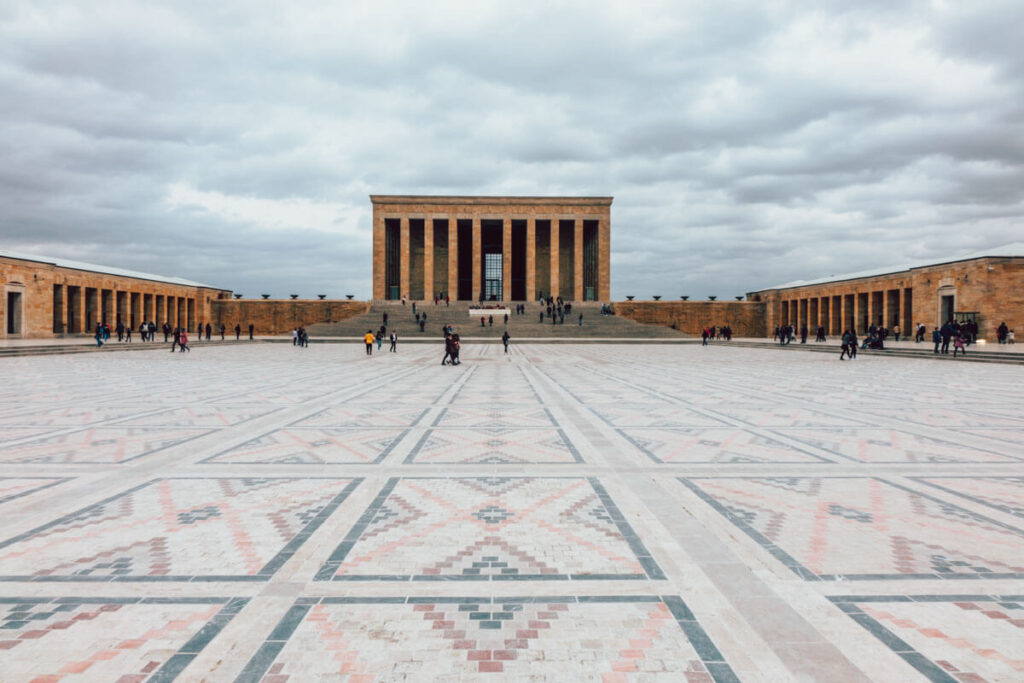
Anitkabir
Explored by Baia of Red Fedora Diary
One of the famous landmarks in Turkey is Anıtkabir, the grand mausoleum of Atatürk. This iconic destination, translated as the “memorial tomb,” stands as a tribute to the life and achievements of Mustafa Kemal Atatürk, the visionary behind the Republic of Turkey. Anıtkabir’s significance is so profound that various banknotes featured it from 1966-1987 and 1997-2009.
The mausoleum’s immensity is immediately evident, composed of four distinct sections: the Ceremonial Plaza, the Road of Lions, the Peace Park, and the Hall of Honor.
Your journey into this monument begins along a 262-meter pedestrian pathway flanked by a symmetrical arrangement of twelve pairs of majestic lions.
The heart of the complex is the Ceremonial Plaza, a sprawling space spanning 129 meters that can accommodate up to 15,000 people. This expansive area boasts 373 Turkish carpet patterns, adding an aesthetic touch to its significance.
Inside the Hall of Honor lies Atatürk’s tomb, the mausoleum’s symbolic element, adorned with columns that rise to an impressive height of 14.4 meters. Adjacent to this is the Peace Park, a serene expanse adorned with approximately 50,000 ornamental flowers, trees, and shrubs gifted by nearly 25 countries.
While Atatürk’s impact and legacy are prominently displayed within Anitkabir, the site is also home to the burial place of Turkey’s second president, İsmet İnönü, since 1973. His resting place faces the mausoleum on the opposite side of the Ceremonial Plaza.
For those seeking a deeper understanding of Atatürk’s life, the Anitkabir Atatürk Museum is one of the essential things to do in Ankara. A vast array of memorabilia chronicles his journey, from his birth certificate to his final days. Among the treasures on display are items, clothing, paintings, and even his 1936 Cadillac. The museum’s layout is thoughtfully designed, allowing you to trace Atatürk’s life and reforms in a chronological sequence that leaves no detail unexplored.
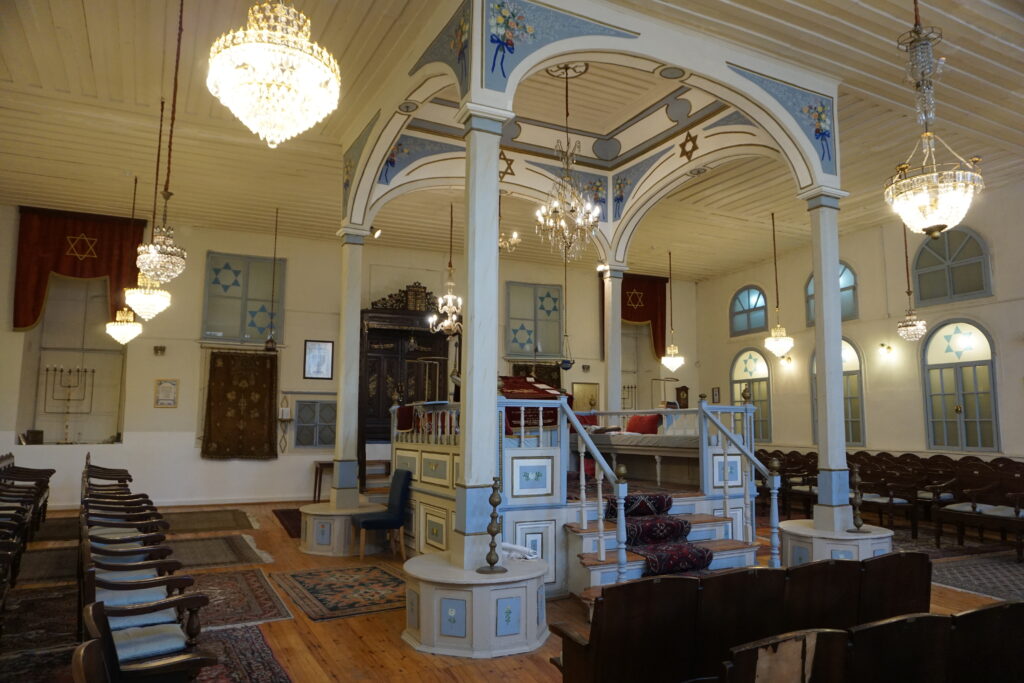
Sephardic Synagogues of Izmir
Within the Kemeralti district of Izmir, you can find the Central Izmir Synagogue complex, a collection of nine adjacent Sephardic synagogues constructed in the 16th century. The Jewish community in Izmir arrived at the end of the 15th century fleeing persecution in Spain and other parts of Europe.
Over the next three centuries, the population flourished, reaching its apex of 50,000 people during the 19th century. They coexisted peacefully with their Ottoman neighbors, exemplified by the mix of synagogues and mosques found in Kemeralti. Kemeralti is the oldest district in Izmir, dating back to Roman times. It contains the densest concentration of Jewish landmarks in all of Turkey standing side-by-side with six mosques.
The nine synagogues that make up the Central Izmir Synagogue Complex can only be visited via guided tour. They are laid out in the Sephardic style, with the elevated bimah (pulpit) placed in the center of the room and surrounded by four columns. Some synagogues are still used for worship, while others are in need of restoration.
The Central Izmir Synagogue Complex provides an invaluable link to the history of Jews in Izmir, which is especially prescient given the population’s decline since 1944. Today, less than 2,000 Jews remain in the city. What remains of the community, however, is dedicated to preserving these vital landmarks and ensuring that the vibrant history of Izmir’s Jewish heritage endures for generations to come.
Turkey’s Famous Landmarks Map
FAQ: Famous Turkey Landmarks
Turkey is home to many famous landmarks, including Istanbul, Cappadocia, Pamukkale, Topkapi Palace, Mount Nemrut, and more.
Istanbul is one of Turkey’s most famous cities and has several iconic landmarks such as Hagia Sophia, the Blue Mosque, and the Grand Bazaar.
Yes, Turkey is rich in historical landmarks, and some of the famous ancient ruins include Ephesus, Troy, and Hierapolis.
Cappadocia is known for its unique rock formations called fairy chimneys, ancient cave dwellings, and hot air balloon rides. It is a famous natural landmark in Turkey.
Pamukkale, also known as the “Cotton Castle,” is a UNESCO World Heritage Site famous for its white terraces formed by mineral-rich thermal waters.
es, Turkey is blessed with many natural wonders. Some other famous natural landmarks include the stunning landscapes of southern, southwestern, and eastern Turkey.
Hagia Sophia, Pamukkale, Ephesus, Troy, and Hierapolis are a few famous landmarks in Turkey that have been recognized by the UNESCO World Heritage List.
Some famous landmarks in Turkey, like Ephesus and Troy, date back to ancient times, while others like Topkapi Palace and Hagia Sophia have their origins in the Ottoman Empire.
Final Thoughts: Famous Landmarks in Turkey
Turkey has an abundance of famous landmarks that are worth exploring, and a trip to Turkey would not be complete without visiting some of the iconic landmarks that dot the country. From the magnificent Hagia Sophia in Istanbul to the ancient ruins of Ephesus, there is something for everyone and every travel style. The country is known for its rich history and diverse culture, which is evident in its famous landmarks. These places not only offer a glimpse into Turkey’s past but also showcase the country’s unique landscapes. Whether it’s the bustling streets of Istanbul or the serene beaches of Antalya, Turkey has it all. Exploring these Turkey landmarks is a journey filled with history, culture, and breathtaking sights.
